HALLIDAY, JAMES (or THOMAS), R. (or L.) (1816-1900). Private, 83rd New York Infantry, Company F. Halliday was originally from Morristown, New Jersey. As per his obituary in the Brooklyn Daily Eagle, he was the youngest of seven children, one of whom, the Reverend S. B. Halliday, was the associate pastor of the Plymouth Church under Henry Ward Beecher (see). Halliday was listed as being employed as a janitor at 35 Washington Place in New York City in 1857. During the Civil War, he enlisted and mustered into the 83rd New York on May 27, 1861, at New York City, and was discharged for disability on June 24, 1862.
Civil War Bio Search
After the War, the U.S. census listed Halliday as a carpenter but in later years he was employed as an undertaker according to Trow’s New York City Directory for 1876-1884 and in the 1880 census. A clerk in 1884, he apparently retired in the late 1880s. His obituary states that he last worked as a merchant. In 1885, his pension application was approved, certificate 555,568. His pension record indicates other service, possibly in the 9th New York, but it is unclear when he served. This is substantiated by an article in The New York Times on May 28, 1892, that lists him as attending a reception for the Veterans’ Association of the Ninth Regiment who left New York as members of the 83rd New York. He last lived 77 Hicks Street in Brooklyn. The cause of his death was attributed to old age. Section 163, lot 16337, grave 1.
HALLIDAY, SAMUEL J. (1847-1922). Private, 56th Regiment, New York State National Guard, Company B. Originally from Ireland, Halliday came to the United States in 1860, according to 1880 census data. During the Civil War, he enlisted as a private in 1864 and served for 100 days in the 56th Regiment. On May 29, 1866, he enlisted in Company B of the 19th U.S. Infantry and served until November 1866. He became a naturalized citizen on October 8, 1872, at which time he was employed as a porter. In 1909, his application for an invalid pension was granted, certificate 1,157,888. His pension record indicates additional service in Company B of the 37th U.S. Infantry. His last residence was 511A Monroe Street in Brooklyn. His death was due to cardiac disease. Section 183, lot 20346, grave 2.
HALLIDAY (or HALLADAY), WILLIAM (1845-1928). Private, 5th New York Heavy Artillery, Company B. A native of London, England, he immigrated to the United States in 1853. Halliday lived in Brooklyn with his parents and five siblings at the time of the 1860 census. After enlisting as a private at Brooklyn on March 23, 1864, he mustered immediately into Company B of the 5th New York Heavy Artillery. At that time, he was a clerk who was 5′ 5″ tall with grey eyes, brown hair and a fair complexion. His muster roll shows that he was sick and in the hospital at Harpers Ferry in October 1864. He was borne on his regiment’s rolls as “William Halladay” when his company mustered out on July 19, 1865, at Harpers Ferry, West Virginia.
The 1870 census shows that he lived in Brooklyn; the 1880 census reports that he worked as a store clerk, and lived in Brooklyn with his wife and three children. In 1908, he applied for and received a pension, certificate 1,149,090. He lived in Brooklyn at 538 Hancock Street in 1900; the census of 1910 indicates that Halliday was a naturalized citizen (no date given), worked as a salesman in the produce industry, and still lived at 538 Hancock Street; he had been married thirty-eight years at that time. A widower at the time of his death, he last lived at 1015 St. John’s Place in Brooklyn with his daughter’s family. He succumbed to edema of the lungs. Section 62, lot 7200.
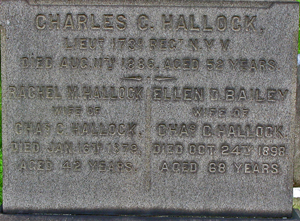
HALLOCK (or HALLECK), CHARLES C. (or A.) (1834-1886). First lieutenant, 173rd New York Infantry, Companies A, F, C, and H. Hallock, who was born in New York, was a house painter according to the census records of 1860 owning real estate valued at $3,000. After he enlisted as a sergeant at Brooklyn on September 3, 1862, he mustered into Company A of the 173rd New York on October 30. On his soldier records he is listed as Charles Halleck. He rose to second lieutenant on May 13, 1863, was transferred to Field and Staff on June 1 upon his promotion to sergeant major on that day, transferred to Company F on August 28, and to Company C on November 10. On June 20, 1864, he was promoted to first lieutenant, was transferred to Company H at some point, and went back to Company C on October 15, 1864. Halleck was dismissed on January 25, 1865.
After the War, Hallock returned to his trade and was still employed as a house painter when the census was taken in 1870 and had real estate valued at $8,500. A widower in 1880, he was then a sign painter and gilder. The Brooklyn Directory for 1886 lists his sign and gilding business at 303 Fulton Street which was also his home address. His second wife, Ellen Hallock, who is interred with him, was granted a widow’s pension in 1890, certificate 378,567. Section 185, lot 22938.
HALLOCK, ISAAC (1840-1916). Private, 13th Regiment, New York State Militia, Company A; acting master, United States Navy. A native New Yorker, Hallock, whose occupation was listed as sailor in the 1860 census, first served as a private in the 13th Regiment. He enlisted on April 23, 1861, and was discharged on August 6. As per his soldier record, Hallock was a 5′ 5″ tall mariner with gray eyes, light hair and a light complexion. He enlisted in the Navy as a mate on October 23, 1861, and rose to ensign on April 2, 1864. He received a promotion to acting master on May 25, 1865, and was honorably discharged on June 8, 1868. During his Naval service, he served on the USS State of Georgia, USS Mercedita, and in the Potomac Flotilla. Hallock worked as a clerk from 1870-1900 and then according to the censuses of 1900 and 1910 was employed as a tea salesman. He received a pension from the Navy, certificate 34,810. At the time of his pension application, he indicated that he had numerous tattoos on his arms including a shield on his left forearm, and another shield, female figure and flag on his left upper arm. In addition, his right upper arm near the shoulder was tattooed with a female figure, globe and flag. He last lived with his daughter, Edith Gooding, at 340 Lewis Avenue in Brooklyn. He died of myocarditis.
Hallock’s daughter kept records of the expenses at the end of her father’s life. The nurse who cared for him from October 30, 1916, through December 7, 1916, charged $25 per week and $4 per day for five weeks and three days totaling $137. Funeral costs including notices to newspaper, casket, floral drape, hearse and coaches to cemetery, opening grave, death certificate, burial, funeral director, chairs and other expenses totaled $188.75. The monument, made by Greenwood Monumental Works included charges of $8.75 for the inscription of “Hallock” on the tombstone, $7.00 for setting the tombstone in the lot, and $18.00 for cemetery charges for building the foundation. Section 18, lot 8463, grave 1.
HALLORAN, JOHN (1845-1899). Private, 3rd New York Cavalry, Company H. Originally from Canada, Halloran enlisted as a private at Poughkeepsie, New York, on September 14, 1864, and mustered that day into the 3rd New York Cavalry. He mustered out on June 7, 1865, at Norfolk, Virginia. His service is confirmed by the 1890 Veterans Census. Halloran last lived at 97 Java Street in Brooklyn. He succumbed to heart disease. Section A, lot 8100, grave 316.
HALPIN (or HALPER), JOHN (1846-1910). Unknown rank, United States Navy. The censuses of 1900 and 1905 indicate that Halpin was born in the United States; however, the census of 1860, lists his birthplace as Ireland. As per the census of 1860, he was living in Brooklyn with his mother and two younger siblings. His obituary in the New York Tribune on June 3, 1910, is headlined, “Veteran Dies Playing Ball.” In that obituary, Halpin is referred to as a Civil War veteran and a retired member of the United States Navy. The details of his service are unknown; his obituary reports that he was “at leisure” after retiring from the Navy. At the time of the census of 1900, he had been married 18 years, was living in Brooklyn in a rental with his wife and daughter, and could read and write. As per his obituary, Halpin died from a heart attack while playing ball at the Parade Grounds, near Prospect Park in Brooklyn. Halpin enjoyed walking and playing baseball there; he fell after a fatal heart attack while engaged in a baseball game. He last lived at 698 Park Place. The obituary incorrectly refers to his wife as Mary; her name was Jennie. The papers accompanying the filing of his will state that his net worth was less than $100. Section 165, lot 28438.
HALSEY, HENRY (1826-1869). Private, 5th New York Heavy Artillery. Halsey, who was born in England, enlisted as a private at New York City on January 13, 1864, and mustered into an unassigned company of the 5th New York Heavy Artillery that day. As per his muster roll, Halsey was a 5′ 10″ tall clerk who had gray eyes, dark brown hair and a dark complexion. Further details related to his service are unknown. He last lived at 208 Spring Street in Manhattan. His death was caused by Bright’s disease. Section 59, lot 15563, grave 88.

HALSEY, HENRY M. (1834-1912). Commissary sergeant, 13th New York Cavalry, Company C. A New York City native, he was a clerk according to the 1850 census and was a grocer in 1860. He enlisted at New York City as a quartermaster on November 3, 1862, was commissioned into Field and Staff of the 13th Cavalry two days later, and mustered out on June 20, 1863, as supernumerary upon consolidation. On March 15, 1864, he was commissioned into Company C as a second lieutenant and acting regimental quartermaster. Subsequently, Halsey was promoted to first lieutenant and commissary sergeant on April 6, 1864, with rank from March 26, and mustered out on August 17, 1865, at Washington, D.C.
In 1880, Halsey was again employed as a store clerk. According to a news article in The New York Times in 1883, he was a complainant to the Board of Health about unpleasant sounding noise from the ringing of bells at a charity mission for the aged on East 70th Street in Manhattan where strong smells also emanated from the building. On October 1, 1894, the War Department issued a document stating that pursuant to acts passed on June 3, 1884. In 1902, his application for an invalid pension was approved under certificate 1,046,185. At the time of his death from pneumonia, he was a resident of 26 McDonough Street in Brooklyn. Section 110, lot 10138.
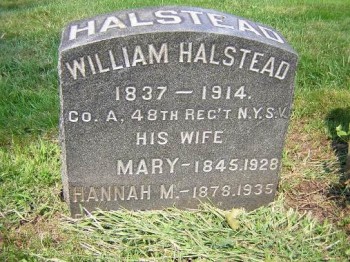
HALSTEAD, WILLIAM (1837-1914). Private, 48th New York Infantry, Companies H and A. Born in New York, he was a carpenter who lived in Brooklyn. After enlisting on August 8, 1861, at Brooklyn, he mustered into Company H of the 48th New York eight days later, was transferred to Company A during his service, and was discharged for disability on about October 15, 1861. He resumed carpentry after the Civil War and was continually employed in that trade, last working for the Board of Education according to the census of 1910. In 1891, his application for an invalid pension was approved, certificate 891,488. As per his obituary in the Brooklyn Daily Eagle, he was a member of Thatford Post #3 of the G.A.R., the 48th Veterans’ Association, and the Brooklyn Volunteer Firemen’s Association. Members of those organizations were invited to his funeral. He died at his residence on Vincent Avenue in Lynbrook, Long Island. Shortly after his death, Mary Halstead, who is interred with him, received a widow’s pension, certificate 787,192. Section 133, l0t 3611.
HALSTED (or HALSTEAD), EDWARD (or EDWIN) L. (1840-1911). Captain and first lieutenant by brevet; second lieutenant, 40th New York Infantry, Company K; United States Army Signal Corps; private, 7th Regiment, New York State Militia, Company L. Born in Jersey City, New Jersey, and a clerk by trade, Halsted first served for 30 days with the 7th Regiment in 1861. According to his obituary in The New York Times, he was one of 600 men who volunteered for that activation. He re-enlisted as a second lieutenant on December 1, 1861, at Alexandria, Virginia, was immediately commissioned into the 40th New York Infantry, and was discharged on May 25, 1862. On March 3, 1863, he was commissioned into the United States Army Signal Corps as a second lieutenant. On August 30, 1864, as per Special Order No. 20, Halsted was announced as acting chief signal officer on the staff of Major General Philip Sheridan and served under him in the Shenandoah Valley. During his four years of service, Halsted was part of the Army of the Potomac. According to his obituary in the Brooklyn Daily Eagle, he also served on the staffs of Generals Crawford, Hatch, Sullivan, Merrick, Sedgwick, Wright and Torbel. He resigned his commission on January 3, 1865. On March 13, 1865, he was promoted by brevet to first lieutenant and captain.
In 1870, the census recorded Halsted’s occupation as a street paver, but he was later listed as a broker in Trow’s New York City Directory for 1878-1888. According to the censuses of 1900 and 1910, he was a clerk at the Department of Water Supply. In 1898, his pension application was filed and approved under certificate 1,083,093. As per his obituary in the New York Herald on July 14, 1911, his death was caused by heat exhaustion. That obituary, which confirmed his service in the Civil War, notes that he was promoted to major and then colonel after being cited for gallantry at the Battle of Winchester. That information is not confirmed on his soldier history or pension record. The obituary in the Brooklyn Daily Eagle states that he was one of four brothers who served a total of over ten years in the Civil War. His last residence was 209 West 81st Street, Manhattan. Emily Halsted, who is interred with him, applied for and received a widow’s pension in 1911, certificate 730,230. At some point, the Seventh Regiment displayed relics from its storied history at the Armory’s annual musical evening. Among them was the signal flag that Halsted used to bring Sheridan back from Winchester and saved the Union Army at the Battle of Cedar Creek, Virginia, in October 1864. Section 62, lot 2162.
HAMBLER, WILLIAM HENRY (1844-1907). Sailor, United States Navy. A Brooklynite by birth, he enlisted in the Navy in 1861 at the age of 16 and served until the close of the hostilities. At the time of his enlistment, he was 5′ 5½” tall with blue eyes, fair skin and dark hair. A real estate agent in the 1870s, he became a pen manufacturer in 1888 with several Manhattan stores including one at 141 Broadway. As per his obituary in the American Stationer, Volume 61, his firm, Hambler & Sons, manufactured fountain pen novelties. Hambler’s name was familiar to fountain pen aficionados who sought his engraved fountain pen roller clip. He was a member of the Grand Army of the Republic, Lafayette Post #140 and a charter member of the Ridgewood Council, Royal Arcanum. His pension application was approved, certificate 38,162. He last lived at 473 Hancock Street, Brooklyn. Apoplexy was the cause of his death. His wife applied for and received a widow’s pension, certificate 19,233. Section 1, lot 12772.
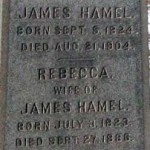
HAMEL, JAMES (1824-1904). Unknown soldier history. According to his obituary in The New York Times, he was member of John A. Dix Post #135 of the G.A.R., an organization of Civil War veterans. The details of his service are unknown. A Freemason, Hamel was also a captain of the Old Guard of the City of New York, the Army’s official ceremonial unit dating to 1784 when it originated as the 3rd United States Infantry. The unit is known for its unique black and tan strap that is worn on the left shoulder. He was a member of the American Institute and belonged to the General Society of Mechanics and Tradesmen for 34 years; members of all those organizations were invited to his funeral. He last resided at 34 West 55th Street in Manhattan. Hamel died of gastroenteritis Section 164, lot 16502, graves 4 and 5.
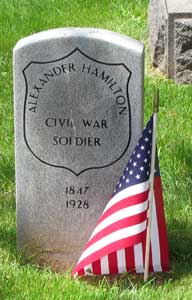
HAMILTON, ALEXANDER (1847-1928). Episcopal clergyman and soldier. Born in Setauket, Long Island, he was a descendant of his namesake, the first Secretary of the Treasury. He was a veteran of the Civil War, serving under his father, Colonel Alexander Hamilton. Educated at St. Stephen’s College near Poughkeepsie, New York, and at the General Theological Seminary in New York, he was ordained a deacon in 1870. In 1871, he was 5’11” tall with gray eyes, brown hair, a high and broad forehead, full face, Roman nose, and fair complexion.
Hamilton became a priest in 1890. He served many churches, including those in Tarrytown, Chappaqua, Mount Kisco, Lewisboro, Armonk, Dover Plains, and Pleasantville, New York, and West Milford, Connecticut. In 1894, he resigned from the Emmanuel Episcopal Church in Weston, Connecticut, where he had been the rector, after his a member of his church was upset when Hamilton’s daughter became engaged to another man and demanded her father’s resignation. He was named rector emeritus of Christ Church, Westport, Connecticut, in 1920. In 1927, he was elected chaplain of the Society of Cincinnati in New York State and was also chaplain of the Connecticut Society of the Sons of the Revolution. He also belonged to virtually every organization denoting membership in an old American family. He last resided in Union Park in Norwalk, Connecticut. Section 170, lot 9042.
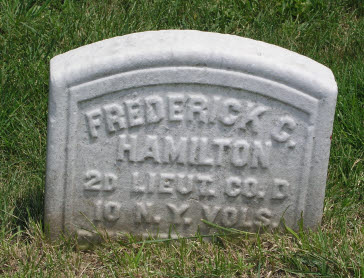
HAMILTON, FREDERICK C. (1831-1905). Second lieutenant, 10th New York Infantry, Companies H and D. Born in Louisville, Kentucky, he was a machinist by trade. On August 28, 1861, he enlisted as a private at New York City, and immediately mustered into Company H of the 10th New York, also known as the National Zouaves. Later that year, Hamilton was promoted to corporal on September 1, to sergeant on November 25, and to first sergeant on December 19. He rose to second lieutenant on July 9, 1862, effective upon his transfer that day to Company D, and resigned on December 10, 1862. One of his obituaries notes that he was an orderly to General Gouverneur K. Warren and was recognized for bravery on the field. That obituary also notes that his title of “colonel” was an honorary one.
Although Hamilton returned to his job as a machinist after the Civil War, he had many other jobs after 1880 including metal-stamper, die-cutter, and locksmith. In civic life, he was active in Brooklyn Democratic Party politics, and was a member of The Thirteen Club, an organization that eschewed any superstitions associated with that number and in which he was the chief ruler. Among Hamilton’s compatriots in The Thirteen Club was George Francis Train, a renowned eccentric, world traveler and businessman, who is also buried at Green-Wood. In 1899, he applied for and received an invalid pension, certificate 915,919. According to his obituaries, he was a member of the Winchester Post #197 of the G.A.R., the Exempt Firemen’s Association, and the Crystal Wave Lodge. He last lived in Brooklyn at 111 St. Marks Place. Shortly after his death in 1905, from cancer of the jaw (he died at the New York Skin and Cancer Hospital in Manhattan), his widow, Rachel Hamilton, who is interred with him, was awarded a pension, certificate 591,220. Section 136, lot 28070, grave 212.
HAMILTON (or HAMBILTON), HUGH G. (1822-1883). Corporal, 63rd New York Infantry, Companies G and A. A native of Kilmarnock, Scotland, Hamilton enlisted as a private on September 7, 1861, at New York City, and mustered into Company G of the 63rd New York on September 24. As per his muster roll, he was a shoemaker who was 5′ 8″ tall with gray eyes, brown hair and a fair complexion. He was wounded in the arm at the Battle of Antietam, Maryland, on September 17, 1862. Hamilton, who was also borne on the rolls as Hambilton, was promoted to corporal on December 24, 1862, then transferred to Company A on June 12, 1863. He was reduced to ranks before he re-enlisted as a veteran on December 21, 1863, and deserted at the expiration of furlough on January 29, 1864. The desertion is probably listed in error because he applied for and received an invalid pension in 1885, certificate 344,194. The 1880 census reports that he was a bookkeeper; the New York City Directory for 1883 lists him as a clerk. He last lived at 322 West 48th Street in New York City. Section 2, lot 5499, grave 1911.
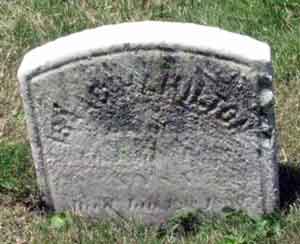
HAMILTON, ISAAC (1822-1889). Corporal, 67th New York Infantry, Company B. Originally from Ireland, Hamilton enlisted as a private at Brooklyn on June 7, 1861, and mustered into the 67th on June 20. On May 31, 1862, he was wounded at the Battle of Seven Pines, Virginia. He was promoted to corporal of his company on May 1, 1863, and mustered out on July 4, 1864, at Brooklyn. In 1887, he applied for an invalid pension, application 426,896, but there is no certificate number. His last address was on King Street in Brooklyn. He died of phthisis. In 1890, his wife applied for and was granted a widow’s pension, certificate 322,536. Section 6, lot 20118, grave 830.
HAMILTON, JOHN C. (1837-1874). Sergeant, 30th Massachusetts Infantry, Company D. Hamilton was born in New York City, although one record incorrectly notes that he was born in Canada. At the time of his enlistment as a private at Lowell, Massachusetts, on October 17, 1861, he was a resident of Newark, New Jersey, and a butcher by trade. After mustering in on November 7, he served with the 30th Massachusetts, and was hospitalized at New Orleans, Louisiana, with chronic diarrhea on May 9, 1863. Hamilton was promoted to sergeant on an unknown date and was discharged for disability on February 5, 1863, at Barracks General Hospital in New Orleans. His discharge papers, which state his rank as commissary sergeant, note that he suffered from “armie diarrhea.” Hamilton’s discharge papers also report that he was 5′ 8½” tall with grey eyes, brown hair and a light complexion. He last lived at 125 Charles Street in Manhattan. The cause of his death was phthisis. In 1882, Elizabeth Hendricks Hamilton applied for and received a widow’s pension, 277,633. Section 102, lot 10826.
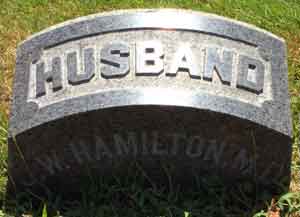
HAMILTON, JOHN W. (1819-1880). Assistant surgeon, United States Navy. Born in Pennsylvania, Hamilton enlisted as an assistant surgeon on November 24, 1861, at which time he was assigned to the USS State of Georgia. On August 23, 1862, seeing that his health was failing and his nephritis returned, he sought to resign. In his letter on that date, he wrote in part,
“…At the time of reporting for duty in the early part of July last, and up to the moment of embarking for this ship, I considered my health perfect, yet already within a single fortnight it is so impaired as to disable me from duty, and to excite the most serious alarm.
Having solicited and receiving the appointment while enjoying the most robust and vigorous health with an eye singly to the suppression of this unnatural and wicked rebellion and having labored toward that end so long as my health would permit me to do so efficiently, I hereby do most respectfully ask that my resignation as Acting Assistant Surgeon in the U.S.N. be accepted and my successor at once despatched to my relief….”
Although the resignation was accepted on September 5, 1862, he revoked that resignation on September 11, reporting that his nephritis had improved and he was too hasty in writing his resignation. He wrote,
“…The resignation was hastily written, while laboring under great excitement incident to the most intense physical suffering. Being now exempt from disease, and the organs acting in a strong healthy manner, I entertain strong hopes in the providence of God of an entire and speedy recovery. Ill health being alone the cause of my resignation, and the cause disappearing there of course remains no motive for the act. My great error was that, in a too great solicitude for duty, I should have been tempted to report myself before I had fully recovered. The insidious and flattering nature of my affliction beguiled me into the belief that I was better than I really was. In health, the country has no son more willing to sacrifice his all in her defence, but thinking that I could be useful only when in health, I was anxious to preserve it no less for my own sake than for that of the cause in which we are engaged.
Permission to go to Hospital either by Survey or ticket of disability being unattainable, the Surgeons in attendance, thought it simply a question of death by slow disease on board.”
Hamilton was then assigned to the USS Vanderbilt on October 11 and subsequently detached to await orders on January 28, 1864. On March 5, 1864, he was detached to the USS Catskill, then served on the USS Maratanza as of August 8, 1864, detached on February 22, 1865, and granted a sick leave. Hamilton then served on the USS Conemaugh as of April 27, 1865, until his resignation was accepted on May 8. Hamilton joined the G.A.R. Rankin Post #10 on April 10, 1877. His last residence was 435½ Classon Avenue, Brooklyn. Angie Hamilton applied for and received a widow’s pension. A physician’s affidavit, written in support of her application, noted that Dr. Hamilton suffered from heart palpitations, kidney disease and rheumatism resulting from exposure during his years in the Navy. His death was attributed to fatty degeneration of the heart. Section 154, lot 26465.
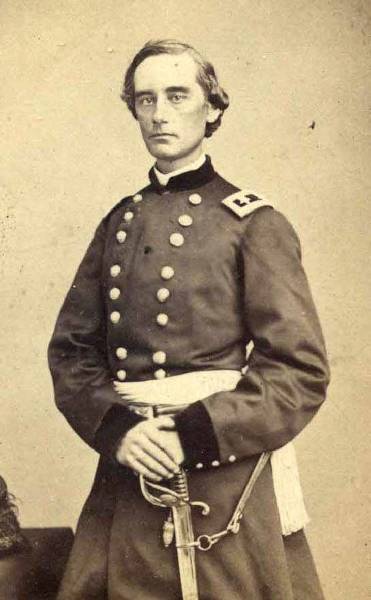
HAMILTON, SCHUYLER (1822-1903). Brigadier general, United States Volunteers. Hamilton was born in New York City, the son of John Church Hamilton (see) and the grandson of Alexander Hamilton. He graduated from the United States Military Academy in 1841 (24th in a class of 52), where he was a classmate of Ulysses S. Grant. After commencement, he was assigned to the frontier, and served as a lieutenant in the 1st Infantry in conflicts with the Indians. Hamilton served at Fort Atkinson, Fort Crawford and Jefferson Barracks before he returned to West Point where he was an assistant instructor in tactics for six months in 1844-1845. He served with honor in the Mexican War. At Monterey on September 21, 1846, he was severely wounded by a ball in the abdomen and suffered a skull fracture. Shortly thereafter, he was brevetted to first lieutenant for his actions there on September 23, and went on sick leave. On April 30, 1847, he was appointed aide-de-camp to General Winfield Scott. At Mil Flores on August 13, 1847, Hamilton received a lance thrust through a lung that broke two ribs and was to pain him for the rest of his life; he was brevetted to captain that day for his actions there, hospitalized and saw no further action in the Mexican War. In November 1848, he was presented with a Tiffany presentation sword by the citizens of New York which was inscribed as follows:
Excelsior Presented to Schuyler Hamilton, Brevet Captain of the United States Army and Aid de Camp of GENL. SCOTT, as a slight Testimony of the admiration and respect of his fellow citizens and friends of New York for his distinguished gallantry and conduct throughout the Mexican War, particularly at Monterey and Mira Flores for which he twice received the honours of promotion, and was appointed AID to his Commander in Chief, that veteran Judge of Military merit and Soul of Honour, WINFIELD SCOTT, General in Chief of the Army of the United States and Conqueror of Mexico. New York, November 1848.
Hamilton continued as aide-de-camp to General Winfield Scott until 1854, the last two years of which he served as secretary to the Board of Commissioner of the Soldiers’ Home in Washington, D.C. In 1854, he authored The History of the American Flag. After resigning from the Army in 1855, he was the administrator of the New Almaden Quicksilver Mine in California, then took up farming in Branford, Connecticut, from 1858 to 1861.
When the Civil War began, Hamilton left his farm and volunteered as a private in the 7th New York, served for a short time on the staff of General Benjamin F. Butler, and then was as aide-de-camp to General Scott, who was then general-in-chief. In his position with General Scott, Hamilton was close to the seat of power in Washington, D.C., and was considered an insider to President Abraham Lincoln’s “War Council.” Hamilton was instrumental in preventing the murder of some Confederate prisoners of war who were captured on the battlefield at First Bull Run, Virginia. After Scott retired, Hamilton, with the rank of colonel, was assigned as assistant chief of staff to General Henry W. Halleck (see), his brother-in-law. Hamilton was commissioned brigadier general in November of 1861, and was given command of the Department of St. Louis where he served in western Kentucky and Tennessee. During 1862, he commanded, in order, the 1st, 2nd, and 3rd Divisions of the Army of the Mississippi. He commanded his division so well that he was promoted to major general in 1862 (but that promotion was not approved by the Senate), was commended by Brigadier General J. Pope in his field report from New Madrid on March 14 of that year for his “zeal and cooperation,” but was forced to resign when stricken with malaria. Jack D. Welsh, M.D., in Medical Histories of Union Generals (1996, p. 148), notes that his medical records also indicated that he had typhoid fever and other grave disorders that necessitated a medical leave dating from July 12, 1862. Although Hamilton tried to return to his duties that November, his health was too frail and he was sent back to New York. By February 1863, the effects of chronic dysentery and enteritis led him to resign for reasons of ill health and disability as of February 27. His condition resulted from the effects of exposure, malaria, and bad water, according to his surgeon’s report. President Lincoln responded to his resignation with “much regret.” Hamilton still hoped to have been promoted to major general but that promotion was never approved, leading Hamilton to conclude that he had been dealt a “grave injustice.”
Hamilton returned to his farm until 1866. From 1871 to 1875, he was the hydrographic engineer for the New York City Department of Docks, but his poor health made regular employment difficult. As per his passport application in 1875, Hamilton was 5′ 11¾” tall with a high forehead, hazel eyes, gray hair, dark complexion, prominent nose, medium chin and oval face. A devotee of literature, he wrote, “The National Flag, the Stars and Stripes, its History in a Century,” and presented it at an address at the New-York Historical Society on June 14, 1877, the centennial of the adoption of the American flag. As per his obituary, one of his sons, Robert Ray Hamilton, was killed under mysterious conditions in the Snake River country in the Pacific Northwest. Schuyler Hamilton died in New York City. In 2018, Hamilton’s presentation sword from 1848 was offered for auction with a minimum bid of $100,000. Section 186, lot 19596.
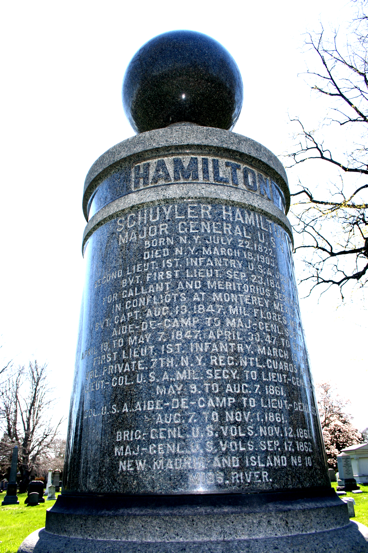
HAMILTON, WILLIAM C. (1837-1911). Provost marshal, sutler. Hamilton was born in Albany, New York. His father, Dr. Alexander Hamilton, conducted the Hamilton Institute, a health resort in Saratoga, New York. As a young man, he worked for the banking firm, Travers and Jerome in New York City. According to his obituary in The New York Times, he served with the 7th Regiment before the Civil War but was the brigade sutler under General Burnside during the hostilities. While not part of the military, a sutler sold provisions and often followed a regiment on its movements to different locations. However, his obituary in the local Bayonne newspaper indicates that he was provost marshal under Generals Hooker, Burnside, and McClellan.
In civilian life, Hamilton was the longest serving city clerk of Bayonne, New Jersey; his service totaled 40 years to that city including his efforts helping draw up the city’s charter. He saw Bayonne grow from a township into a community of 60,000 residents. Lawyers and other officials who had an interest in Bayonne consulted him because of his extensive knowledge of city affairs. Active in civic organizations, he belonged to the Hudson County Board of Freeholders, the Elks and Freemasons among other community groups. His obituary in the Jersey Journal stated that flags on city building would fly at half-mast for 30 days to honor his memory. His last residence was 49 East 33rd Street in Bayonne. The cause of his death was apoplexy. Section 78, lot 4057.
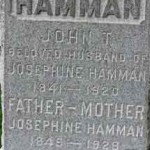
HAMMAN, JOHN THEODORE (1841-1920). Private, 13th Regiment, New York State Militia, Company C. Hamman served as a private with the 13th Regiment from April 23-August 6, 1861. According to the Brooklyn Directory of 1888-1890, he was employed as a clerk. In 1901, his pension application was granted, certificate 1,050,066. His last residence was 213 Lee Avenue in Brooklyn. His death was attributed to senility. Josephine Hamman applied for and received a widow’s pension shortly after his death in 1920, certificate 897,182. Section 83, lot 20996.
HAMMELL (or HAMMALL), CHARLES F. (1837-1915). Corporal, 139th New York Infantry, Company K. Hammell was born in Philadelphia, Pennsylvania, and moved to New York City in 1852. He enlisted as a private at New York City on August 18, 1862, and mustered into the 139th New York on September 9 with a promotion to corporal. He was in many campaigns of the Civil War including these in Virginia: Williamsburg, Chapin’s Farm, Drewry’s Bluff, Bermuda Hundred, Swift Creek, and the Battle of Cold Harbor. After Cold Harbor, he was detached from the 139th New York and by order of General Butler moved into the Provost Marshal’s Office where he served in the Departments of Virginia and North Carolina. He was placed in command of distribution at the Bermuda Hundred, Virginia, was present at the capture of Richmond, Virginia, the Confederate capital, and at the liberation of Libby Prison there. It was mentioned in orders that the first Union officer to enter that notorious facility was Lieutenant Colonel Albert Ordway (Provost Marshal) and his aide Corporal Charles F. Hammell. Ordway placed Hammell in charge of the commissary needs of the liberated prison. On June 15, 1865, he returned to the 139th New York Infantry and mustered out with his company four days later at Manchester, Virginia.
Hammell returned to Brooklyn after he mustered out and resumed work as a carpenter. Active in military affairs, he was a member of the 139th Regiment War Veteran Association, treasurer of the Grand Army of the Republic’s William Rankin Post #10, and then a member of the Ulysses S. Grant Post #327. When President Ulysses S. Grant died at Mt. McGregor, New York, he was among the first to be at that site to stand guard by the fallen president. Hammell’s application for an invalid pension in 1898 was approved under certificate 969,277. He died at the National Soldiers’ Home in Hampton, Virginia, where his records indicated that he was a carpenter by trade who was 5′ 8″ tall with gray eyes and hair and a light complexion. As per his obituary in the Brooklyn Standard Union, which confirmed his Civil War service, Hammell’s comrades from the G.A.R. took charge of his funeral service. In 1916, Mary A. Hammell, who is interred with him, applied for and received a widow’s pension, certificate 808,971. Section 207, lot 20849, grave 3.

HAMMILL (or HAMILL), BENJAMIN F. (1846-1865). Private, 84th Regiment, New York State National Guard, Company A. Born in New York City, Hammill’s service as a private in the 84th Regiment during the Civil War is recorded on his government-issued gravestone, circa 1900. Further details are unknown. On February 20, 1865, he died of smallpox. His last residence was at 44th Street and Broadway in Manhattan. In 1873, Eleanor Hamill, his mother, applied for a pension, application 210,936, but it was never certified. Section 59, lot 3748.
HAMMOND, ALBERT W. (1846-1873). Private, New York Marine Light Artillery, Company B. After enlisting and mustering in as a private at New York City on September 18, 1861, he deserted from the New York Marine Light Artillery on an unstated date. Hammond drowned at North River, New York, while on a picnic with the Jersey City John Brown Association when he stepped off from the towboat onto the barge and fell overboard; the police found his body five days later off Fort Washington Point in north Manhattan. He last lived at 487 Henderson Street in Jersey City, New Jersey. Section 41, lot 5108.
HAMPE, EMIL (or EMILE) CARL (1829-1917). Private, 4th United States Army, Band. A native of Brunswick, Germany, Hampe enlisted on December 16, 1863, and mustered into the Band of the 4th United States Regular Army. The Brooklyn City Directory for 1864 lists Hampe as a musician. His pension index card notes that he had additional service as a private in that same regiment from December 1866 to January 21, 1867. He mustered into the John Adams Dix Post #135 of the G.A.R. on May 11, 1881; at that time, he was a clerk who lived in Brooklyn. The New York City Directories for 1882-1883 and 1876-1878 list Hampe as a musician. In 1890, his application for an invalid pension was approved, certificate 616,120. Hampe last lived at 843 Monroe Street in Brooklyn. His death was attributed to an enlarged prostate. Shortly after his death in 1917, Margaret Hampe, who is interred with him, applied for and received a widow’s pension, certificate 834,557; on the pension index cards, his name is listed as Carl E. Hampe. Section 35, lot 27150, grave 1.

HAMPSON, ROBERT E. (or ALFRED) (1840-1898). First lieutenant, New York Marine Light Artillery, Company K; second lieutenant, 13th New York Heavy Artillery, Companies L, M, and D. At the start of the Civil War, Hampson was a recruiter for a regiment known as the “British Volunteers” and offered it for State service on April 21, 1861. This effort was abandoned after the infamous Trent affair when Mason and Slidell were removed from the aforementioned British ship. In July 1861, a company was raised as the “British Volunteers” and became Company C of the 19th Infantry Regiment (Veteran). Some of the companies that he recruited were ordered to join the 36th New York but that did not materialize. One of the companies became McClellan’s Rifles, later incorporated into the 90th New York.
Hampson enlisted as a first lieutenant at New York City on April 30, 1862, mustered into the New York Marine Light Artillery on that date, was borne on the rolls through October 1862, but was never commissioned. Further details of that enrollment are unknown. On April 16, 1864, he re-enlisted as a private at Williamstown, New York, mustered into Company L of the 13th New York Heavy Artillery, and was commissioned as a second lieutenant Of Company M on November 14, 1864, with rank from July 25. He was transferred to Company D on June 4, 1865, and mustered out on July 18, 1865, at Norfolk, Virginia. In 1897, he applied for an invalid pension, application 1,185,603, but it does not appear to have been granted. A broker and clerk in civilian life, he last lived at 727 Lexington Avenue in Brooklyn. He died from smallpox. Section 134, lot 29725, grave 98.
HAMPTON, ZACHIAS (or ZACHENS, ZACCHEUS) (1840-1905). First sergeant, 84th New York (14th Brooklyn) Infantry, Company H. Born in England and a watchmaker by trade, he enlisted as a private on April 18, 1861, at Brooklyn, mustered into the 14th Brooklyn on May 23, was promoted to first sergeant on January 1, 1863, and mustered out on June 6, 1864, at New York City, as Zaccheus Hampton. In 1893, his application for an invalid pension was approved under certificate 1,032,970. At that time, he was suffering from rheumatism that he contracted while in military service. Still employed as a watchmaker, he was 5′ 2½” tall with brown eyes, dark hair and a light complexion. His last residence was in Brooklyn. The cause of his death was listed old age. In 1905, Catherine Hampton applied for and received a widow’s pension, certificate 614,352. Section 189, lot 16335, grave 5.
HAMRE, HENRY (1843-1906). Acting ensign, United States Navy. Born in Stavanger, Norway, Hamre was a mariner who lived on Market Street in Manhattan when he first enlisted in the United States Navy on November 15, 1860, and served until August 1862. At that time, he was 5′ 4″ tall with gray eyes, brown hair and a light complexion. He re-enlisted as a mate on September 1, 1862, and was promoted to acting ensign on July 31, 1863, at which time he was assigned to the USS Montgomery. Subsequently, he was detailed to the USS Paul Jones from August 25, 1863, through September 23, 1864, then served on the USS Merrimac until March 10, 1866. He then served on the USS Bermuda until he was honorably discharged on January 21, 1866.
At the time Hamre applied for an invalid pension in 1904, he stated that after his discharge in 1866, he spent 18 years “following the sea,” then was employed in the transportation business and was currently working at the New York Navy Yard. At the time of his application, Hamre was 5′ 7½” tall, 168 pounds, with blue eyes, grayish hair and a pale complexion. He had a tattoo of a crucifix on his left arm and a tattoo of a marine coat of arms on his right wrist. As per his medical report, he was suffering from catarrh and rheumatism. His application for an invalid pension was approved under certificate 35,159. According to his death certificate, he was a ship-builder by trade and died of pulmonary tuberculosis. His last residence was at 561 40th Street in Brooklyn. Christine Hamre applied for and received a widow’s pension from the Navy under certificate 18,308. Section 128, lot 31502, grave 81.
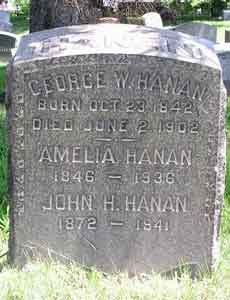
HANAN (or HANNON, HAMAL), GEORGE W. (1842-1902). First sergeant, 40th New York Infantry, Companies E and D; corporal, 87th New York Infantry, Company E. After enlisting as a private at New York City on November 29, 1861, he mustered into the 87th New York the next day. He became a corporal on March 1, 1862, and transferred to the 40th New York as a private on September 6, 1862. Rising through the ranks, he became a corporal on November 1, 1862, transferred to Company D on May 25, 1863, and apparently was reduced in rank at some point and promoted again to corporal on April 6, 1864. Hanan was promoted to sergeant on May 2, 1864, to first sergeant a month later on June 1, returned to Company E on July 7, and mustered out on June 27, 1865, at Washington, D.C. In 1887, he applied for and received an invalid pension, certificate 888,934. He last lived at 475 Sterling Place in Brooklyn. Hanan’s death was caused by phthisis. Amelia Hanan, who is interred with him, received a widow’s pension in 1902, certificate 546,183. Section 136, lot 28307, grave 919.
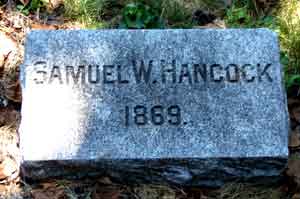
HANCOCK, SAMUEL (1844-1869). Corporal, 84th New York (14th Brooklyn) Infantry, Company E; 5th New York Veteran Infantry, Company H. A native of New York City, Hancock enlisted at Brooklyn as a private on September 1, 1862, and mustered into the 14th Brooklyn two days later. A bookbinder at the time of his enlistment, he was 5′ 7¼” tall with hazel eyes, light brown hair and a fair complexion. He was promoted to corporal on December 1, 1863, transferred into the 5th New York Veteran Infantry on June 2, 1864, and was wounded at the Battle of Weldon Railroad, Virginia, on August 18, 1864. He last lived in Rutherford Park, New Jersey. Section 150, lot 12401.
HANKINSON, THOMAS D. (or B.) (1842-1897). Corporal, 3rd New York Infantry, Company B; private, 9th New York Infantry, Company H. A native of New York City, he enlisted there as a private on August 29, 1862, and mustered into the 9th New York the next day. As per his muster roll, he was a clerk who was 5′ 8″ tall with blue eyes, brown hair and a fair complexion. He served until May 6, 1863, on which date he was transferred into the 3rd New York Infantry. Hankinson was promoted to corporal at some point, lost his right arm at the Battle of Petersburg, Virginia, and was discharged for disability on July 12, 1865. Remaining active in military affairs, he was a member of the John A. Dix Post #135 of the G.A.R. as of November 7, 1884. In 1884, he applied for and was granted an invalid pension, certificate 38,966. An employee of the Department of Public Works in New York City for 34 years, he was the superintendent of the reservoir in Central Park at the time of his death from “mortification.” As per his obituaries which confirmed his Civil War service and injury, he was active in G.A.R. affairs; members of Post #135 were requested to attend his funeral in post uniform. His death was from consumption which he contracted at the National Encampment of the G.A.R. at Louisville, Kentucky, the previous year. He last resided at 85th Street and Transverse Road in Manhattan. Sarah E. Hankinson applied for and was granted a widow’s pension in 1897, certificate 446,011. Also in 1897, an application was granted for a pension for a minor child, certificate 470,417. Section 135, lot 14964, grave 203.
HANNA, JAMES (1842-1871). Private, 48th New York Infantry, Company E. Of Irish origin, Hanna enlisted as a private at Brooklyn on August 21, 1862, and mustered into the 48th New York on that day. As per his muster roll, he was a marble cutter by trade who was 5′ 5″ tall with blue eyes, brown hair and a light complexion. On July 18, 1863, he was wounded at Fort Wagner, South Carolina, and named on the casualty list. This is the brigade attack in which the 54th Massachusetts participated–as depicted in the movie Glory. George Crockett Strong (see) was the brigadier general who commanded the attack (and was himself mortally wounded there). Hanna was later detached as a hospital nurse in Washington, D.C., and was discharged on an unknown date. He last lived at 167 Willow Place in Brooklyn. He died of consumption. Section 133, lot 16873, grave 12.
HANNA (or HANNAN), SAMUEL (1839-1897). Private, 22nd Regiment, New York State National Guard, Company I. Originally from Ireland, Hanna enlisted at Brooklyn as a private in 1863. He mustered into Company I of the 22nd Regiment for its activation of 30 days and mustered out with his company at the expiration of his enlistment. As per the census of 1880, he was a laborer. He joined the Grand Army of the Republic on February 2, 1889. His last residence was 308 Decatur Street in Brooklyn. His death was attributed to phthisis (tuberculosis). Section 24, lot 6776, grave 6.
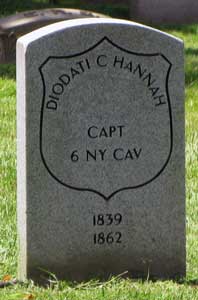
HANNAH (or HANNAHS), DIODATI (or DEIDAY) CUSHMAN (1839-1862). Captain, 6th New York Cavalry, Company F. Born in Otsego, New York, Hannah entered Yale College in 1854, left in the middle of his freshman year, returned in September 1855, and graduated with the class of 1859. He then entered a law office in Choate, New York, while attending lectures at Columbia Law School. During the Civil War, Hannah enlisted at New York City as a first lieutenant on October 24, 1861, and was commissioned into the 6th New York Cavalry, also known at the Ira Harris Guard, that day. He was promoted to captain a month later on November 11. At the time of his promotion, a group of his college classmates presented him with a cavalry saber.
As per a biographical sketch in a Yale yearbook, his regiment wintered in York, Pennsylvania, transferred to Perryville, Maryland, in February 1862, and then was attached to the Peninsula Campaign in Virginia. Stationed in Yorktown, Virginia, under the command of General Erasmus D. Keyes, Hannah was called upon to support the troops that were attacked by Confederate cavalry who dashed into Williamsburg and forced Union troops to flee. On September 9, 1862, his company was detailed to re-establish the pricket line in advance of enemy forces. He was mortally wounded by a ball through the lung that day and died from his wounds the following morning. His Yale classmates remembered him fondly. One recollection from the class of 1861 reports how Hannah was tenderly carried by McKinney, a Yale classmate, to a transport that brought the wounded home. McKinney remained with Hannah throughout the last night of his life, a faithful and caring act of kindness. His classmates from the class of 1858 said of him,
…Mature beyond his years, he won respect at once; genial in his nature, he drew to him many friends. He died in the service of his country, beloved by all his companions and regretted by many more who knew him only as an acquaintance. The manly qualities which he evinced at Yale, showed themselves conspicuously during his short career in the army, and though death did not come to him in the hour of battle, (which most men count so great an honor) it summoned him at a much more trying moment,-“into an air of glory, whose light doth trample on our days.”
An excerpt from the eulogy from his class of 1859:
…His death was a cruel stroke to the hopes and affections of all who knew him. Who can bear the thought that so much glorious manhood should fall so early, that a heart so noble and true should moulder, that so much promise should be blighted in the dawn of his career! Truly these trying times have borne no bitterer fruit. A gallant soldier is lost to the Republic, a terrible chasm is in the ranks of ’59; and oh, what desolation unspeakable and inconsolable in those hearts which were bound to his in the communion of intimate friendship. The memory of that rare fellowship will be treasured in many breasts-a sacred fire fed with the choicest oil of affection, to be extinguished only with the breath of life.
Section 61, lot 13621.
HANNAN (or HANNON), JOHN P. (1826-1880). Private, 82nd New York Infantry, Company K; 59th New York Infantry, Company K; Veteran Reserve Corps. A native of Ireland, he enlisted at New York City as a private on November 6, 1861, and mustered into the 82nd Infantry that day. On July 10, 1864, he transferred into the 59th New York, and transferred into the Veteran Reserve Corps on August 5. His muster roll indicates that he was sick and absent on several occasions including a hospitalization in Philadelphia. He last lived in Flatbush. Section 188, lot 15297.
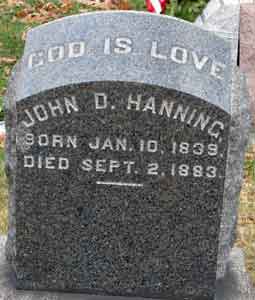
HANNING, JOHN D. (1839-1883). First lieutenant, 2nd Rhode Island Cavalry, Companies E and C. A Brooklyn native, Hanning enlisted on January 15, 1863, as a first lieutenant, the same date that he was commissioned into the 2nd Rhode Island Cavalry. He was transferred intra-regimentally to Company C before he mustered out on August 28, 1863, at New Orleans, Louisiana. His last residence was 716 Atlantic Avenue in Brooklyn. He died of Bright’s disease. In 1886, Emma Hanning applied for and received a widow’s pension, certificate 317,378. Section 188, lot 21423.
HANNON (or HANNAN, HERMAN, HENNON), JOHN (1830-1881). Private, 69th New York Infantry, Companies D and B; 19th Regiment, Veteran Reserve Corps, Company C. A native of Ireland, he enlisted at New York City as a private on August 13, 1862, and mustered immediately into Company D of the 69th New York, known familiarly as the “Fighting Irish.” Hannon, was also borne on the rolls as Hannan, Harman and Hennon. He was wounded at the Battle of Antietam, Maryland, on September 17, 1862. Hannon was transferred to Company B of the 69th on June 12, 1863, and then to the 19th Veterans on an unknown date. He returned to Company D of the 69th New York on June 14, 1864, and was detailed to the Ambulance Corps. He mustered out on June 5, 1865, at Alexandria, Virginia. In 1880, his application for an invalid pension was approved under certificate 231,171. His last residence was 39 Chrystie Street in Manhattan. Section 2, lot 5499, grave 1167.
HANSEN, JOHN (1822-1870). Bugler, 1st New York Cavalry, Company I. Originally from Copenhagen, Denmark, Hansen enlisted as a bugler at New York City on August 1, 1861, and mustered into the 1st New York Cavalry that day. As per the muster roll, he was a mechanic who was 5′ 6″ tall with blue eyes, dark hair and a dark complexion. Hansen was discharged for disability on February 14, 1862, at Camp Kearney in Alexandria, Virginia.
After his discharge, Hansen worked as a painter and lithographer. One of his paintings, Yacht America, is pictured below. As per his obituary in the New York Tribune, he died suddenly at his home on April 4, 1870, at 173 South Street in Manhattan. The obituary identifies him as a marine artist. Friends, acquaintances and New Jersey, New York and Sandy Hook pilots were invited to attend his funeral, from the undertaker’s, at 61 Cherry Street. He was interred at Green-Wood soon after his death, then re-interred to another location on March 12, 1871. Although his wife applied for a widow’s pension, application 261,522, it was not granted. Section 180, lot 15264.
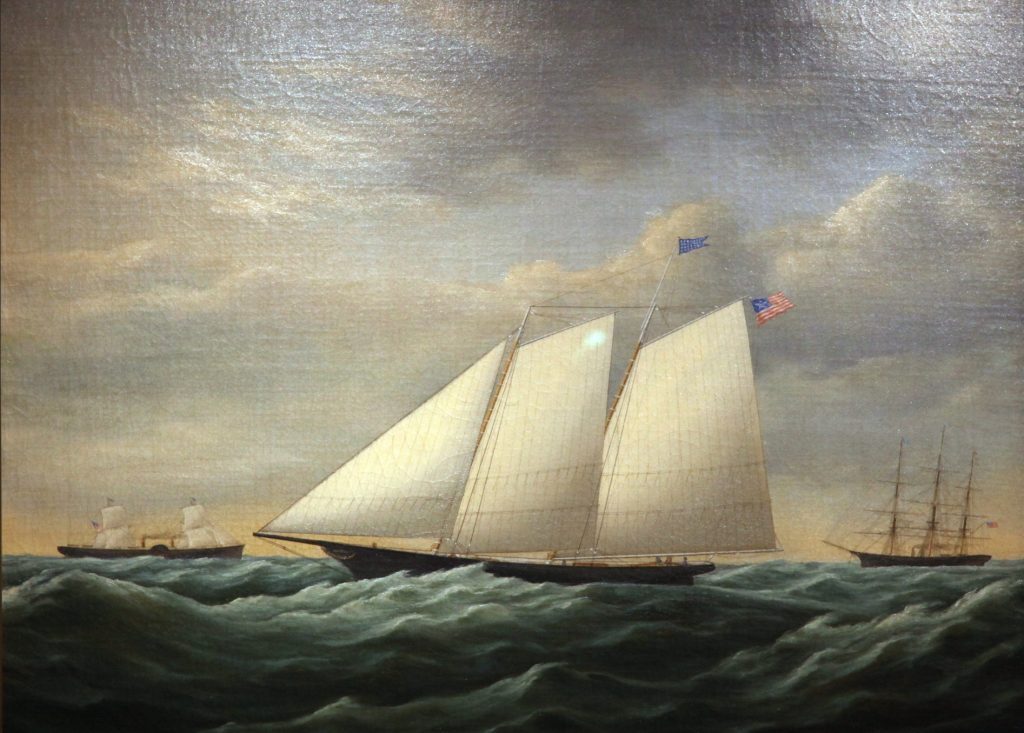
HANSON, PETER (1836-1888). Captain, 56th Regiment, New York State National Guard, Company D. Hanson served in 1863, enlisting and commissioning into the 56th National Guard on June 18 at Brooklyn, and mustering out there on July 24. He last lived on Furman Street in Brooklyn. His death was attributed to paresis. Section 2, lot 5499.
HANSEN (or HANSON), LEWIS (1820-1881). Private, 158th New York Infantry, Company D. Born in Norway, he was borne on the rolls as Lewis Hanson. He enlisted as a private at Brooklyn on November 21, 1863, and mustered into the 158th New York on that same day (Another record gives the enlistment date as November 2 with an immediate mustering in date). His muster roll indicates that he was a laborer who was 5′ 5½” tall with blue eyes, fair hair and a light complexion. According to one record, he deserted from Hammond General Hospital in Beaufort, North Carolina, on July 7, 1864. However, that might be inaccurate because another record indicates that he mustered out from Hammond Hospital on that date. As per his death certificate, he was a clerk. He last lived at 341 Sackett Street in Brooklyn. Section 122, lot 17806, grave 202.
HARDIE, JAMES ALLEN (1823-1876). Major general and brigadier general by brevet; colonel and inspector general, 5th United States Artillery. Born in New York City, he attended the Western Collegiate Institute at Pittsburgh, Pennsylvania, and the Poughkeepsie Collegiate School in New York. An appointee of President Martin Van Buren, Hardie graduated from the United States Military Academy in 1843, 11th in his class, and entered the artillery. He taught geography, ethics, and history at West Point from 1844 to 1846, then commanded a New York Regiment of Volunteers in the Mexican War. After converting to Catholicism, he helped during that war to raise funds to build the first cathedral in San Francisco. Hardie served in garrison, frontier, and Indian service until the onset of the Civil War at which time he was adjutant general of the Department of Oregon.
On May 14, 1861, Hardie transferred to the 5th United States Artillery, was promoted to lieutenant colonel on September 28, 1861, and served as lieutenant colonel and aide-de-camp on the staff of General George B. McClellan accompanying him in the spring of 1862 to the Virginia peninsula as adjutant general of the Army of the Potomac and then to Maryland at the Battle of Sharpsburg (Antietam). He subsequently joined the staff of Major General Ambrose E. Burnside where he assisted at the Battle of Fredericksburg, Virginia. During the Battle of Fredericksburg, he delivered the attack orders to General William B. Franklin on December 13, 1862. Franklin did not conduct his attack to Major General Burnside’s expectations, and Hardie was criticized for not ensuring that the two generals understood each other correctly. He was appointed brigadier general of volunteers on November 29, 1862, but his name was not submitted to the United States Senate for confirmation and that appointment was revoked on January 22, 1863.
Appointed to major and assistant adjutant general in the Regular Army on February 19, 1863, he served as Assistant Secretary of the War Department. It was Hardie who carried the secret orders at the end of June 1863, on the eve of the Battle of Gettysburg, Pennsylvania, to Major General George Meade as Commander of the Army of the Potomac replacing Joseph Hooker in that position.
On October 17, 1863, President Abraham Lincoln wrote a note (see photo below) authorizing Hardie to perform the duties of the Secretary of War and the Assistant Secretary during their absence. Hardie was appointed colonel and inspector general on March 24, 1864. He then served as assistant secretary to Secretary of the Army Edwin M. Stanton, and as judge advocate of the Army of the Potomac. On March 3, 1865, he was brevetted brigadier general of the United States Army for distinguished and faithful service during the War and brevetted major general for faithful, meritorious, and distinguished service in the Inspector General’s Department; the United States Senate confirmed the appointment on March 9.
In 1866, Hardie was the commissioner who audited military claims of Kansas, Montana, Dakota, California and Oregon. On March 6, 1866, President Andrew Johnson nominated Hardie to brevet major general of the regular army; the brevet was confirmed by the Senate on May 4 and again on July 14, 1866. On December 6, 1866, he acknowledged and accepted his promotion by brevet to major general. He then was at headquarters of the Army from August 15, 1867, through May 17, 1869, inspector-general of the Division of the Missouri until October 5, 1872, at headquarters of the Department of the Gulf until January 14, 1873, in Baltimore until February 1873, and then on inspection duty in Philadelphia, Pennsylvania. On December 21, 1875, he wrote to President Ulysses S. Grant, offering his services in the President’s cabinet. He wrote:
To the President,
Dear General,
I think there is a fair chance of the Indian Department being turned over to the War Department this Session.
In case it should, please consider me a candidate for Commissioner of Indian Affairs; if Army officers are to be detailed.
Some few years ago, you may remember the same proposition came up and I was then spoken of as a fit candidate, but then I did not care for it. Now I would like it. I feel entirely confident that I could satisfy your Administration in this place.
I have lived among Indians and know them and their management; and I think within the last ten years I have seen as many Indians on the frontier as most Army officers. And besides, I have spent years in my earlier life, as you know, in frontier service.
My wife and myself when you were here did our best to pay our respects to Mrs. Grant and yourself. We failed to have the pleasure and the honor of seeing you. But if we had known that you were not to leave the city until the next day, we should have gone to see you again.
I am, General,
Your friend & Servant
Jas. A. Hardie
In 1876, he was elected as a Companion of the Pennsylvania Commandery of the Military Order of the Loyal Legion, a patriotic organization of Civil War officers. Hardie died of jaundice while on active duty in the Army on December 14, 1876, in Washington, D. C. George W. Cullum in his tome, Biographical Register of the Officers and Graduates of the United States Military Academy, said of Hardie, “His thirty-three years in the Army were spent almost entirely in staff duties, although he saw some combat in the Union Army during the War between the States.” On December 28, 1876, his widow asked General E. D. Townsend to secure written testimony attesting to Hardie’s character so that she could appeal to Congress for a widow’s pension. Originally interred at Mount Olivet Cemetery, he was re-interred at Green-Wood on March 17, 1877. Section 68, lot 2175.

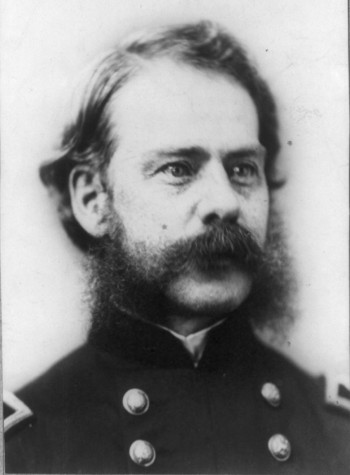
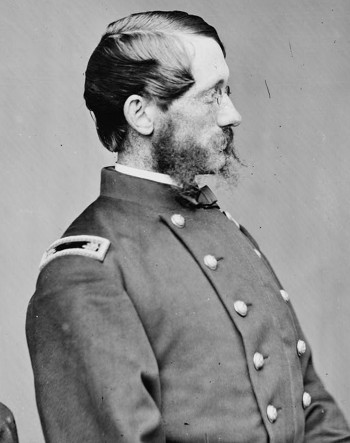
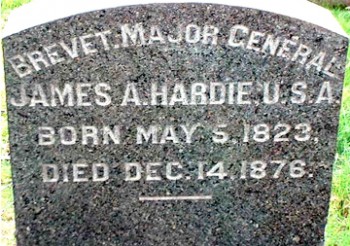
HARDING, EDWIN A. (1821-1864). Private, 4th New York Heavy Artillery, Battery H. As per the records of the United Methodist Church of New York City in 1846, Harding was identified as a probationer for membership. The New York City Directory for 1857 lists him as a clerk at 67 Allen Street. At age 41, he enlisted as a private at New York City and mustered into Battery H of the 4th New York Heavy Artillery. He died of disease at Washington, D.C., on December 10, 1864. Section 101, lot 7718.
HARDING, GEORGE (1828-1873). Private, 43rd New York Infantry, Company F; rank unknown, United States Navy. A New York City native, Harding was a sailor at the time of his enlistment. After Harding enlisted as a private at New York City on January 9, 1863, he mustered into the 43rd New York on February 28. As per his muster roll, he was 6′ ½” tall with blue eyes, black hair and a dark complexion. He was listed as absent and sick in the hospital in April 1863. On April 17, 1864, he transferred into the United States Navy from which he was discharged. His last residence was in New York City. His death was caused by peritonitis. Section 17, lot 17245, grave 1781.
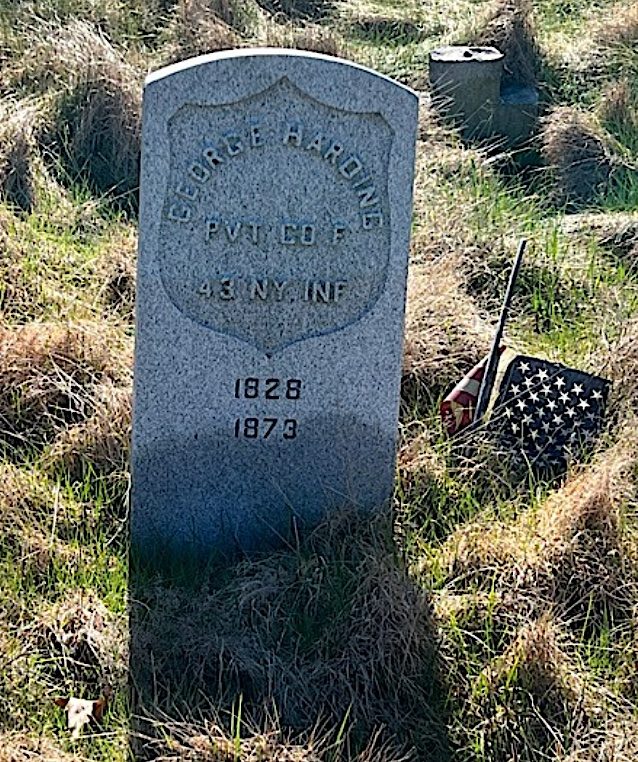
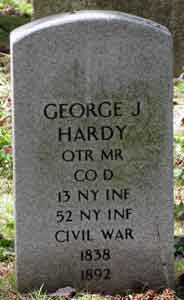
HARDY, GEORGE J. (1838-1892). Quartermaster, 52nd New York State National Guard; second lieutenant, 13th Regiment, New York State Militia, Company D. Hardy enlisted on April 23, 1861, at Brooklyn, was commissioned into the 13th Regiment as a second lieutenant on that date, and mustered out at Brooklyn on August 6, 1861. Commissioned into the same regiment and company on May 28, 1862, then part of the National Guard, he was detailed as an assistant quartermaster for three months, and mustered out at Brooklyn on September 12, 1862. He re-enlisted and was promoted to quartermaster on June 19, 1863, the same day he was commissioned into the 52nd National Guard’s Field and Staff to serve 30 days, mustering out on July 25 at Brooklyn.
During his lifetime, Hardy was active in the Republican Party from the time of its inception, and was a leader in local politics in South Brooklyn holding minor positions in the party. Hardy, tall and muscular, was indefatigable in his political work and at the forefront of Republican conventions as a delegate. He ran unsuccessfully for the position of county clerk. As per his obituary in the Brooklyn Daily Eagle, he was connected with the United States Internal Revenue Collector’s Office early in his political life and was a chief government witness during the “whisky wars.” However, according to an article in the Albany Evening Journal of September 20, 1867, Hardy was arrested for aiding T. C. Callicot, a collector who was trying to defraud the government of monies owed on whisky, and was held on $20,000 bail. Hardy also served as a deputy sheriff. In the last years of his life, he changed his political affiliation, hoping for a political appointment that did not occur. Hardy was a member of the Thomas Devin Post #148 of the G.A.R., the Volunteer Fire Department, the Greenwood Commandery, the Freemasons and the Knights Templar. His obituary in the New York Tribune reports that, at the time of his death, Hardy had a suit for $15,000 against the Brooklyn City Railroad Company for injuries received while riding a streetcar. His last residence was 284 Clinton Street in Brooklyn. Section 82, lot 2474.
HARDY, WILLIAM (1826-1906). Sergeant, 4th Regiment, New York Heavy Artillery. A native New Yorker, he was an apprentice at the Novelty Iron Works in Manhattan before becoming chief engineer on the steamship Florida. Subsequently, he was superintendent of Reynolds, Devoe & Pratt (later Reynolds & Devoe, paint and bush manufacturers), and remained with that firm for thirty years. During the Civil War, Hardy served for 30 days with the 4th Regiment, New York Heavy Artillery when the unit was organized at Harrisburg, Pennsylvania, on June 20, 1863. The 4th Heavy Artillery was part of the Gettysburg Campaign and mustered out on July 24. In about 1880, he joined the firm of H. W. Johns Company, a roofing and insulation company, remaining with them for twenty-one years until his retirement in 1900. As per his obituary, he was active in the Protestant Episcopal Church of the Messiah and then in the Church of the Redeemer. In 1905, he and his wife, Jane, celebrated their golden (50 years) wedding anniversary. A Brooklyn resident for forty-five years, he last lived at 103 St. John’s Place. Section 203, lot 26856, grave 2.
HARE (or HAIR), JAMES (1837-1869). Private, 13th Regiment, New York State Militia, Company F. A native of Ireland, Hare enlisted at New York City as a private in 1861, mustered into the 13th Regiment, and mustered out when his enlistment terminated after three months. As per his obituary, members of the 45th Police Precinct were invited to attend his funeral, which may indicate that he was a police officer. His last residence was on Gates Avenue in Brooklyn. In 1890, Esabella Hair was awarded a widow’s pension, certificate 359,565. Section 189, lot 18601.
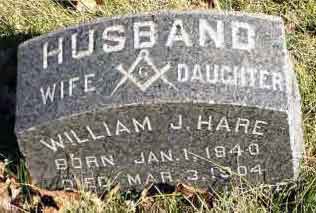
HARE, WILLIAM J. (1840-1904). Corporal, 84th Regiment, New York State National Guard, Company I. Of Irish birth, Hare was a corporal in the 84th Regiment when it was activated for 100 days in 1864. In 1897, his application for an invalid pension was approved under certificate 1,068,825. His last residence was 165 Beech Street in Yonkers, New York. Shortly after his death from valvular heart disease in 1904, Elizabeth Hare, who is interred with him, applied for and received a widow’s pension, certificate 606,222. Section 136, lot 28307, grave 1032.
HARMAN, JOHN P. (or B.) (1826-1880). Hospital steward, 133rd New York Infantry, Company G. Of English origin, Harman enlisted as a private at Brooklyn on August 24, 1862, and mustered into the 133rd on September 24. As per his muster roll, he was a druggist by trade who was 5 ‘1½” tall with blue eyes, red hair and a light complexion. On January 1, 1863, he was promoted to hospital steward but on October 13, 1863, he was reduced in rank to private. He was listed as absent and sent to the hospital from Bolivar Heights, Virginia, in October 1864, and returned to the muster rolls later that month. He mustered out on June 6, 1865, at Washington, D.C. His last address was in Flatbush, Brooklyn. His death was attributed to phthisis pulmonalis and exhaustion. Section 188, lot 15297.
HARNED, DAVID (1830-1919). Corporal, 71st Regiment, New York State Militia, Company H. A native of New York City and a bookbinder by trade, Harned enlisted there on April 20, 1861, and mustered into the 71st Regiment. The regiment engaged in the occupation of Alexandria, Virginia (May 21, 1861); fought in skirmishes in Virginia at Aquia Creek (May 31-June 1, 1861); Matthias Point (June 27, 1861); and Bull Run (July 21, 1861). He was discharged at New York City after serving three months on July 30.
After the War, Harned worked for the Tax Department and then the Commissioner of Records of the City of Brooklyn as a custodian and binder of books. The Brooklyn Directory for 1876 reports that he was a bookbinder. He was active in Republican Party politics in the Thirteenth and Nineteenth Wards and was a member of the Congress Club of the Eastern District. In addition, Harned was a member of the Henry M. Lee Post #21 of the G.A.R. At the time of his admission to the Soldiers’ Home in Bath, New York, on August 16, 1918, he was 5′ 6″ tall with blue eyes, grey hair, light complexion and was able to read and write. As per his obituary in the Brooklyn Daily Eagle, he was a member of the Kings County Civil Employees Benevolent Organization and the Veteran Association of the 71st Regiment in addition to the G.A.R.; members of those associations were invited to attend his funeral. His obituary in the Brooklyn Standard Union, which confirms his Civil War service, noted that at the time of Harned’s death, only 17 members of the Henry Lee Post were still alive and that he had been a volunteer fireman. Both obituaries indicated that he worked until a year before his death. He last resided on Keap Street in Brooklyn but died at the Soldiers’ Home ten months after his admission. His death was attributed to arteriosclerosis. Section 106, lot 10766.

HARNETT (or BARNETT), EDWARD B. (1834-1865). Captain, 72nd New York Infantry, Company A. Of Irish origin, Harnett became a naturalized citizen in the 1850s. During the Civil War, he enlisted at New York City as a second lieutenant on May 27, 1861, and was commissioned into Company A of the 72nd New York on June 21, 1861. Company A was organized in New York City in May 1861, of mostly German recruits. He was promoted to first lieutenant on May 17, 1862, and to captain on August 5, 1862. A news article, Return of a Disabled Officer, which was published when Harnett returned home on sick leave, reported that he fought in Virginia at Williamsburg (where he was injured), Bull Run, Bristoe, Fredericksburg, Chancellorsville, and at Gettysburg, Pennsylvania. He was listed as sick (at home and on sick leave) and absent when his company mustered out. His honorable discharge was dated from June 30, 1864, the date his company mustered out at Petersburg, Virginia. On October 2, 1864, the examining surgeon reported that Harnett had chronic bronchitis which he had contracted in December 1862, was emaciated and feeble, had trouble speaking and most probably, was permanently disabled. He filed for an invalid pension on October 20, 1864, application 53,577, but he died before it was certified. His last residence was 236 Ninth Avenue in Manhattan where he succumbed on January 1, 1865.
After his death in 1865, his mother, Frances Harnett, filed for and received a survivor’s pension, certificate 119,944. Harnett’s personal physician noted tuberculosis, rather than chronic bronchitis, as the cause of death in support of his mother’s pension application. His mother, a widow, and other witnesses in their affidavits, declared that she was left a widow with no property in 1860, and depended on her son’s earnings for most of her support. (Her only other income came from boarders and contributions of friends.) His remains were originally in lot 8527 and were removed on October 24, 1882, to another Green-Wood lot where his gravestone is inscribed with his military service and where his mother is interred. Section 75, lot 8255.
HARNICKELL, ALBERT G. A. (1838-1887). Captain, 84th New York (14th Brooklyn) Infantry, Company F. Born in Hanau, Germany, Harnickell enlisted at Brooklyn on April 18, 1861, became a naturalized citizen on April 24, and was commissioned into the 14th on May 23. On July 21, 1861, he commanded Company F at the Battle of First Bull Run. He wrote a detailed report of the “Engagement at Bulls Run”:
July 1 -15th at Camp Porter Arlington July 16th took up the line of march toward Fairfax Court House July 17th Bivouacked the night halfway 18th Took possession of Fairfax Court House with the rest of the Division; some spoils from the enemy and marched on next day to below Centreville; bivouacked with the brigade.
July 21st at 3 a.m. started with the Regiment for the Field of Battle where we arrived at about 2 o’clock. Position of the Company in the left wing next to Capt. Stears flank (Co. E). Owing to the scanty supply of food while in bivouac and on the march as well as the fatigue necessarily following upon long marches without rest, but especially in consequence of having to run in the double-quick step for a mile or more immediately preceding our arrival in the hot sun, the men were physically in a very sorry condition for a fight.
The first ‘charge’ resulted in nothing except the receipt of a few cannon balls and a change of position of the Regiment, which was drawn into a safer place while the Captain of this company was suddenly seized with an affliction of the brain (epilepsy?) and remained behind when and where he had an opportunity of seeing that the Regiment was moved off just in time to get out of the range of 5 guns which threw their balls scattering around him. The Captain soon recovered somewhat and followed the Company when we engaged in firing from a lane upon an unseen enemy in the woods, this Company and the flank company alone remaining in position while the right wing and center went for cover behind the fence.
In the absence of any command, the Captain picked up the Eagle and Ring lost or shot off from our flag and ordered the Company to jump behind the fence, the enemy’s fire having ceased.
The Company, as a general thing, behaved very well, though too excited, and followed the movement of the Regiment. The Captain and First Lieutenant feeling too weak to run any longer, the former gave the command of the company to Lieut. James H. Jordan (see) for the time being and did not resume the same until at the last charge made on the enemy’s batteries.
The Company behaved extremely well while making a charge with the Fire Zouaves, fired by their courageous leader, and doing some visible damage to the enemy, but the attack was in vain. The last attack was one of the bloodiest scenes on record in military history and a movement hardly having any precedent in good military tactics, an order of battle for which we have yet to hear the apology.
The left wing of our Regiment had to stand the worst of the fire and stand it bravely. The balls from all sides and of all descriptions flew around us like hail in a storm. Four times we discharged our muskets. Some men showed a disposition to crowd behind and the Captain had to use his sword to establish order. Still, our men were brave as lions and only when they received the command did they turn to retreat.
Casualties: Dead and wounded in enemy’s hands 17. Slightly wounded 5. The Captain and party retreated one way and Lieutenant Jordan and party another, while Lieut. Salten was lost right off. Having rallied around our colors, it was decided to make the best of our way to Centreville, this being the appointed rendezvous by order of General Porter…. Myself and the rest of the company after many adventures arrived successfully and safely at the place.
The demoralization consequent upon the retreat has been a sad blow to this company as well as others, deserting and sly disobedience of orders having become the order of the day. I cannot now count buy 31 effective men
July 26th Broke up Camp Porter and are now quartered new Arlington House. Amongst other evidences of the hot fire, nearly every man in the Company has a bullet hole in his uniform somewhere.
“The following officers and men distinguished themselves at Bulls Run particularly. I was satisfied with the conduct of all but 3 or 4. ….. But 2 of our men threw away their muskets; the rest brought them to camp.
While in brigade bivouac the company was sent on a night’s duty alone to guard a large baggage train reported to have been cut up by the enemy. We marched in proper order, skirmishers out a distance of 6 miles toward Fairfax Court House, and back, executed orders satisfactorily and finished up ½ mile this side of the camp. …
On October 20, 1862, Major William DeBevoise (see) of the 14th wrote him a letter of thanks after learning of his resignation, “…I have also to express the regret I must feel in losing the services of an officer who has so often proved himself of value, and at a time when our strength is so sadly reduced by sickness and the casualties of the battlefield…” He fought in Virginia at the Battles of Bull Run, Falls Church, Gainesville, Groveton, Second Bull Run, and in Maryland at South Mountain and Antietam. He was discharged on September 29, 1862. On April 6, 1865, Harnickell reported that the following ordnance stores were lost, taken or destroyed while he was in command:
6. Springfiled rifled muskets, cal. 58
26. Muskets. Cal. 69. 1. Non-com. officers sword.
3. Bayonet scabbards. 6. Cartridge boxes
5. Cartridge box plates. 19. Cartridge box belts.
19. Cartridge box belt plates. 3. gun slings.
2. Non-com. officers’ sword belts and plates.
6. Waist belts privates. 4. Waist belt plates.
5. Ball screws. 11. Screw drivers and cone wrenches.
38. Wipers.
In 1866, he worked as a broker at 69 Wall Street in Manhattan; in 1880, he worked at the New York Metal Exchange at 85 Maiden Lane in Manhattan. He was a member of the War Veterans’ Association of the 14th Regiment of Brooklyn and served as its treasurer in 1871. His papers at the Brooklyn Historical Society indicate that he re-enlisted and served in the New York State National Guard after the Civil War. Those papers are open to researchers and include the following: a roster of the 84th Regiment of the New York State Militia, vouchers and receipts for military supplies, an account book, military passes, correspondence, a booklet War Sketches from Cedar Mountain to Bull Run, a draft of rules for the 14th Regiment Veterans’ Society, papers and news clippings relating to Harnickell’s activities as a veteran, invitations to receptions and regimental reunions, ephemera, and a pamphlet of Civil War sketches. The collection also includes four photographs: 84th Regiment’s headquarters at Camp Marion, Upton Hill, Virginia; another of a group of Civil War soldiers (presumably Company F); and two of Captain Harnickell in uniform. According to his obituaries, which confirmed his Civil War service, he was a member of the New York Metal Exchange for many years with a focus on copper mining. At the time of his death from cerebral apoplexy, he lived at 448 Putnam Avenue in Brooklyn. Section 166, lot 25715.
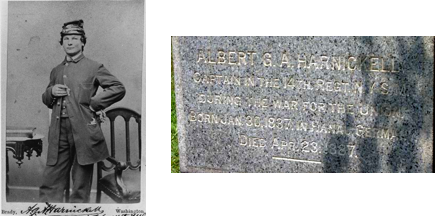
HARPER, DAVID ANDERSON (1837-1918). Captain, 17th New York Infantry, Company C; corporal, 21st New York Infantry, Company F; 13th Regiment, New York State Militia Heavy Artillery. Harper, a Brooklyn native, was a bookkeeper by trade. As per his obituary in the Brooklyn Standard Union, his family was prominent in Brooklyn Heights and his father was a cousin of the founder of Harper Brothers publishers. After enlisting as a corporal on May 7, 1861, at Buffalo, New York, Harper mustered into the 21st New York two weeks later on May 20. As per his muster roll, he had hazel eyes, light hair and a light complexion. He was reduced to ranks on August 9, 1861, and mustered out on May 18, 1863, at Buffalo. On October 5, 1863, he re-enlisted at New York City as a first lieutenant and was commissioned into the 17th New York the same day. He rose to the rank of captain on May 30, 1865, served as an acting aide-de-camp on the staff of Brigadier General Henry A. Barnum as of June 19, 1865, and mustered out on July 13, 1865, at Alexandria, Virginia. Harper also served in the 13th Regiment, New York State Militia Heavy Artillery. On May 18, 1891, he received a letter from the War Department notifying him that he was officially commissioned as a first lieutenant and captain of the 17th New York to date respectively from October 5, 1863, and May 30, 1865. In 1895, he applied for and was granted an invalid pension, certificate 1,033,260. He last resided at 831 Putnam Avenue in Brooklyn. His death was attributed to arteritis, an inflammation of the walls of the arteries. His widow, Mary Harper, who is interred with him, applied for a pension, application 1,213,386. Section 94, lot 739.
HARPER, JAMES (1834-1908). Corporal, 70th New York Infantry, Company D. Born in Scotland, Harper enlisted as a corporal at New York City on May 9, 1861, and mustered into the 70th on June 21. He was admitted to Mill Creek Hospital at Fortress Monroe, Virginia, on May 11 or 12, 1862, one of a group of soldiers who had arrived wounded from the battlefields at Williamsburg and West Point, Virginia. As per his muster roll and the report of the treating doctor, Harper was incorrectly listed as a deserter on his regiment’s muster roll due to his absence at muster after the battle when in fact he had been hospitalized and treated for injury. His treating doctor reported to his superior, Surgeon John M. Cuyler, Medical Director of the Department of Virginian, stationed at Fortress Monroe:
At your request, I transmit for publication a list of patients admitted into Mill Creek Hospital, those transferred, and those who have died in the Hospital. Owing to the hurry and confusion of opening a new hospital, and receiving immediately so many badly-wounded soldiers, without a regular clerk to attend to the register, some inaccuracies may have occurred, but there have been very few. It may be proper to state, for the relief of the anxiety of those who may see the names of their relatives and friends in the list, that the great majority of the wounded now remaining are doing remarkably well, and are quite comfortable. The deaths that have occurred have been from terrible gunshot wounds, principally of the thigh, shattering the bone, and known to be almost always mortal under any treatment and any circumstances.
Harper was on that list of wounded. He was discharged for disability on April 1, 1863, at Convalescent Camp. His last home was on Perry Street in Manhattan. His death was caused by pneumonia. Section 199, lot 28866, grave 1.
HARRADAY (or HANADAY), CHARLES E. (1839-1884). First sergeant, 84th New York (14th Brooklyn) Infantry, Company D. Harraday, a gilder by trade, enlisted as a sergeant at Brooklyn on April 18, 1861, mustered into the 14th Brooklyn on May 23, and was promoted to first sergeant on October 11 of that year. He mustered out on June 6, 1864, at New York City. As per his obituary in the Brooklyn Daily Eagle, he was a letter carrier in Brooklyn and member of the Fourteenth Regiment War Veterans; members of the Fourteenth Veterans were requested to assemble at his late residence for his funeral. He last lived at 142 North Portland Avenue in Brooklyn. He succumbed to meningitis. Section 36, lot 1202.

HARRINGTON, WARREN (1844-1897). Private, 2nd New York Infantry, Company F. Originally from Troy, New York, Harrington enlisted there on April 29, 1861, mustered into the 2nd New York on May 14, and mustered out at Providence, Rhode Island, on January 2, 1863. In 1895, his application for an invalid pension was granted, certificate 893,914. He last resided at 31½ Macdougal Street in Manhattan. His death was attributed to Bright’s disease. Adell Harrington, who is interred with him, was awarded a widow’s pension in 1897, certificate 477,951. Section 134, lot 29725, grave 162.
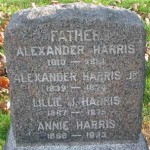
HARRIS, ALEXANDER (1839-1874). Private, 15th New York Engineers, Company C. Originally from Scotland, Harris enlisted at New York City as a private on May 9, 1861, and mustered into the 15th Engineers on June 25. He was captured by Confederate forces on January 11, 1863, and held as a prisoner of war at Richmond, Virginia, until he was paroled on May 15, 1863, a month before he mustered out on June 25, 1863, at New York City. In 1884, his application for an invalid pension was approved under certificate 561,981. His last residence was 204 Broome Street in Manhattan. He died from cerebro spinal meningitis. His wife applied for and received a widow’s pension, certificate 473,356. Section 115, lot 21037.
HARRIS, DANIEL (1846-1915). Landsman, United States Navy. According to his obituary in the Brooklyn Daily Eagle, Harris immigrated to the United States from London, England, when he was sixteen. During the Civil War, Harris enlisted at Brooklyn as a landsman in the United States Navy on August 19, 1864, on the USS Vermont, a receiving ship. A cigar-maker, he was 5′ 7½” tall with hazel eyes, brown hair and a dark complexion. He was transferred to the USS Miami at City Point, Virginia, and then to the USS Malvern from which he was discharged at Hampton Roads, Virginia, on September 15, 1865. His obituary states that he served in Admiral Farragut’s squadron and fought at Mobile Bay, Alabama. Harris was court-martialed for scandalous conduct when he attempted to make a raid on a bum-boat while alongside the USS New Hampshire on August 1, 1865, at Port Royal, South Carolina. In that incident, he conducted himself in a riotous and disorderly manner contrary to the code of good discipline and good morals. He was found guilty and sentenced to thirty days of solitary confinement in double chains, on bread and water with loss of three months pay. (His time in confinement was ultimately deducted from his pensionable service.) He re-enlisted on September 25, 1865, at New York City, and served on the USS Monongahela, USS Ohio, USS Don, USS Guard, and finally served in Lisbon, Portugal, on the USS Franklin from which he was discharged at Gibraltar on October 10, 1868.
A cigar-maker by trade, Harris was president of the New York State Workmen’s Federation and was active for more than 20 years in the labor movement both locally and nationally. In an article in The New York Times on July 9, 1894, Harris, then president of the New York State Federation of Labor, expressed the solidarity of his membership with the American Railway Union in their strike against the Pullman Company. Notably, in one of the resolutions that evening in support of the striking railway workers, the group stated its opposition to anarchist acts that brought disgrace to the union movement. Harris fought hard for the passage of the workmen’s compensation law and was an officer of the Central Federated Union. In addition, Harris was a member of the Grand Army of the Republic, Gouverneur K. Warren Post #286 and Mansfield Post #35. He was awarded a pension from the Navy in 1912, as per the Act of February 6, 1907, certificate 40,828, at the rate of $13.50 per month based on his age and length of service, adjusted to less than one year because of his court-martial. At the time of his application, he was 5’8½” tall, weighed 197 pounds and was scarred with an abscess on the right side of his neck. His pension application states that after his discharge from the Navy, he had lived in many cities across the United States, ultimately settling in New York City in 1907. The obituary noted that the Farragut Veterans conducted his funeral at which Samuel Gompers, the president of the American Federation of Labor, was expected to attend along with other labor leaders. His last residence was 447 81st Street in Brooklyn. He died of heart disease. Section 205, lot 29995, grave 1.
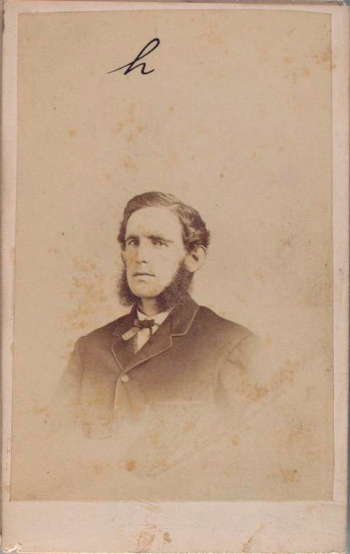
HARRIS, ISAAC (1839-1907). Corporal, 13th Regiment, New York State National Guard, Company A. After enlisting at Brooklyn, his birthplace, on May 28, 1862, he mustered into the 13th that day, and mustered out after three months at Brooklyn on September 12. He had additional service and, at some point, he began working for the Sanitary Commission at Washington, D.C., where he became chief clerk. In that capacity, he traveled to Pennsylvania in 1863, during which time he kept a diary from mid-June through mid-July assessing the build-up of Rebel forces beginning near Fredericksburg, Virginia, and reporting on conditions in Gettysburg after the battle (he was not in Gettysburg, July 1-3, 1863, when that battle occurred). In an early diary entry on the way to Acquia Creek, Virginia, en route to Washington, D.C., Harris wrote on June 14:
All night we tore down and packed up and by four o’clock had the car and all our wagons loaded. Then for a parting salute to Fredericksburg which we have watched for so long a time. All the debris of the camp was piled up, and the match applied and we sat around on the ground watching the fire-sipping coffee and munching hard-tack. At 5:30 a.m. we started for Acquia, but found the roads so blocked by [wagon] trains that it was noon when we reached Potomac Creek. Here a broken down Sutler’s wagon was encountered, loaded with all sorts of good things. In about two minutes our selection was made and transferred to our wagons and on we went, fording the Creek just below the bridge in three feet of water. We reached Acquia at sundown and found everything in confusion. Our steamer, the Lizzy, was nearly full, and here were fifty tons yet to go aboard. The army was away off to Hartwood Church, hurrying after Lee- and the Rebs from Fredericksburg had reached Potomac Creek and were picking up stragglers. By midnight we had everything on board the boat and were only waiting for a convoy to Washington as the Rebs are reported to have batteries on the river. I slept on the hurricane deck on a piece of sail for a bed from which some one rolled me during the night and was soundly kicked for his indiscretion. The idea of stealing a bed in the Army!!
By June 18, Harris and his comrade, Dr. W.S. Swalm, field inspector of the United States Sanitary Commission, had arrived in Harrisburg, Pennsylvania, where the citizens are awaiting reinforcement from New York Regiments as Rebel forces are reportedly everywhere. Feeling ill, Harris wrote on the 19th:
Not at all well this morning, so after breakfast took possession of a sofa in the parlor and dozed until dinner. Swalm says Quinine is the only thing for me, and I am taking it, six grains three times a day-until my ears each have a hand-organ in full blast in them. Rode out to Camp Curtin to see the N.Y. Regts which are coming in rapidly, but had to return to my room and to bed, leaving Swalm to go to the Capitol to send off dispatches.
Assigned to General Joseph F. Knipe of Pennsylvania, the divisional commander, Harris wrote on June 22:
Sick as usual. About 2 P.M. word came in that our cavalry were skirmishing at Smoketown, seven miles out, and lost 2 killed and 1 wounded and 7 horses injured, but were holding their own. This caused some excitement and the Militia who had arrived worn out, suddenly became very fresh to march…back. The Genl. told me that if the enemy advanced his orders were to fall back slowly upon Carlisle and H’bg [Harrisburg] and that he should probably do so about dark as they were in considerable force and “sassy.” About dusk, as I was lying in bed asleep, there was a terrible commotion in front of the house of running horses and men and some firing. Saw in one glance what was going on-the Rebs had made a dash, and in two seconds was dressed, out of the room, down stairs, out of the back door to my horse and off. Above the Court House met Gowan swearing at the Militia and trying to make them stand, but it was no go. They would stand, but not still. However, with cavalry, we made a little show and charged through the square with about half a Squadron and started the Rebs on the back track. Secured my haversack at the Hotel and pistol belt which I had dropped in the stable, not having taken time to buckle it on when I mounted, and at 9 o’clock left on the train, being afraid to attempt to ride as I was weak and had a violent headache since the excitement of the skirmish had passed off. Found a man in the 71st who promised to have my horse at Carlisle by daylight. The train ran very slowly and reached Shippensburg by 12 o’clock. Took supper and started again at 1:30 A.M. Reported that left wing of 71st captured by mistaking the road. Carlisle by 4 o’clock and turned in at the Mansion House.
June 25, 1863:
Met Col. Gowan early this morning and learned something about the movements down the valley. He thinks the Rebs are “ducking it” in order to keep our forces here from uniting with Meade who has succeeded Hooker in command of the Potomac Army. He estimates their strength at not over 5000 and has urged Couch and Knipe to drive them back which he claims can be done without a battle by advancing East of South Mountain when they will fall back or be captured and have the road open to Meade who is in Maryland. Saw Genl. Williams who does not agree with Gowan, but thinks it best to hold this point without risking an engagement which if disastrous would have the entire State open to Lee should he escape Meade. Genl. Crooke and staff arrived today and look greener than any of the boys in the Brigade. During the afternoon with Dr. Swalm began a regular course of inspection of various camps and Regts. of the Post, but found there was scarcely any need of it, as most of the men have been on one or two campaigns and know how to care for themselves, and being just from home are well provided with money and necessities…..
On June 27, 1863, he wrote:
Did nothing in the morning. Wrote letters in the afternoon. Excitement in town runs high. Rebs reported advancing and the Militia falling back. It is a sort of Fox and Geese game at best and nobody hurt. It appears certain however that the enemy have occupied Mechanicsburg between here and Carlisle. Troops are being hurried across the river and it is estimated there are 25,000 over there now. Fort Couch is completed and manned by two Rgts. It mounts two batteries of 10 pdr-Rodman and one four gun battery of light 12’s. York is reported to have surrendered at 6:20 this evening, which if correct begins to look a little like war. Swarm is certain we shall have a fight near here and on the rampage because we have no stores here, and has been telegraphing all over the country. No goods-no horses-no money-no letters from home-no nothing-so go to bed.
During the Battle of Gettysburg, his primary work consisted of checking on stores that were arriving from Philadelphia. Although his diary notes the fighting at Gettysburg and his belief that the troops have held their own, he wrote on July 5:
…reported this P.M. that Lee has been totally defeated in the battles of the 1st-4th and that Meade has captured 25000 prisoners and 118 guns. 2000 paroled prisoners, mostly of the 1st Corps passed through on their way East today, which would seem to indicate that Lee was so hard pressed as to be unable to hold them. Swalm and McClellan left for Gettysburg this P.M. at 4. ….
Harris received word about the injured and his diary entries after the Battle of Gettysburg indicate the work that he did in helping the wounded. On July 6, 1863, he wrote from Philadelphia:
Two hospitals have finally been established in town, one in the old Cotton Factory and the other on East Walnut St. The C.F. under charge of Dr. Crane has 85 patients mostly foot sore Militia, and in East Walnut St. in charge of Dr. Steiler are 118 sick. None of the cases are serious and are well provided by the Govt. However, supplied them with some few necessaries, such as Farina and Jellies. Numbers of wounded and sick principally Rebels are reported to be at Shippensburg and Chambersburg, and sadly deficient in Hospital material. Rec’d message from Gov. Curtin to call on him and did so at once. Requested me to take supplies for 1000 patients to Carlisle. Made selection of stores at once and telegraphed to Philada. for some one to relieve me as I cannot leave the stores here alone during Swalm’s absence. …Turned in at 12:30 with directions to be called at 4. Swalm returned at 2 A.M. and reported a great victory for our arms at Gettysburg, but with a terrible loss of killed and wounded, and no hospital accommodations. Reported my interview with the Gov. and rec’d instructions from S. [Swalm] to follow Gen Couch’s command wherever they went and supply Hospitals in the towns and villages through which they passed, drawing on the stock at Harrisburg or any other San. Com. Depot or where this was impossible by purchase.
Harris continued to visit hospitals and provide supplies. The Christian Commission, another relief organization that had a “healthy competition” with the Sanitary Commission, also brought supplies to the sick and wounded. He visited the hospital at Dickinson College in Carlisle, Pennsylvania, on July 7 to check on supplies and request tin ware and utensils that were needed. Harris wrote on July 10 and July 11, about his visit to a Rebel facility:
…Found 70 Reb. Patients under charge of Dr. (?) Hamilton M. Gamble-20th Va. Inf. (Reb) & nephew of Gov. Gamble of Mo. Hospital in horrible condition and without supplies of any kind, the patients lying on the bare floors, without covering of any kind, and even without dressing for their wounds, and the entire place infested with vermin. The sight was sickening. In fact, the most horrible I have yet met with. Telegraphed to Swalm to send complete outfit for the Hospital and then wrote particulars. Rec’d answer to my dispatch that good would be along on morning train. Informed Dr. Gamble who returned profuse thanks on behalf of his patients.
July 11, Saw Dr. G. at breakfast. He informed me that he had never regularly studied medicine, but after acting as Hospital Steward one year, he had been appointed Surgeon. When the Rebs evacuated Chambersburg he voluntarily remained with his patients. He is certainly a gentleman, whatever may be his professional failings….
As per his obituary, which confirms his Civil War service and assignment to the Sanitary Commission, he was, after the War, a director of the City Savings Bank and the Prospect Park Bank in Brooklyn. He last lived at 125 St. Mark’s Avenue in Brooklyn and died of apoplexy. His widow, Carolyn Wilson Harris, who is interred with him, sought a pension in 1909, application 917,961, but it apparently was not certified. Section 184, lot 28901, grave 5.
HARRIS, NATHANIEL HARRISON (1834-1900). Brigadier general, Confederate States of America; captain, 19th Mississippi Infantry, Company C. Harris was born in Natchez, Mississippi, and was a graduate of the University of Louisiana Law School (now Tulane). A practicing attorney when the Civil War began, he enrolled on May 14, 1861, at Vicksburg, Mississippi. He soon organized the Warren Rifles, and captained his men when they entered Confederate service as Company C of the 19th Mississippi, and was at Richmond, Virginia, on June 11. On the muster rolls, his company was known familiarly as N. H. Harris’ Company, Mississippi Volunteers. Harris was part of General Johnston’s Valley Campaign and marched to Manassas, but arrived too late to participate in the battle there on July 21, 1861 (First Bull Run). In October 1861, he was absent for ten days due to illness. From February 9-April 3, 1862, he was on recruiting duty, subsequently rejoining his regiment. Although he and his men saw little action until the spring of 1862, they then fought in the Peninsula Campaign where he spent twenty-one days in the trenches at Yorktown, Virginia, under constant shelling, and daily skirmishes with the enemy. He also engaged in battles in Virginia at Williamsburg (where Harris earned a commendation and was slightly wounded), Seven Pines, Gaines’s Mills, and Second Bull Run, and at Antietam, Maryland.
Harris rose through the ranks being promoted to major (backdated to May 5, 1862), and was wounded at the Battle of Frazier’s Farm, Virginia, necessitating his absence for ten days. Harris was in command of his regiment at the latter battle. After he returned to the front, he was wounded severely on August 30, 1862, at Second Bull Run (or Manassas), resulting in his absence from September 15-October 5, 1862. He was promoted to lieutenant colonel on November 24, 1862, then colonel on April 2, 1863 (although he dated his colonelcy to December 1862 in a handwritten report to headquarters). He led a regiment of Mississippians at Chancellorsville, Virginia (where they took part in Stonewall Jackson’s flank attack), and at Gettysburg, Pennsylvania (where they attacked Meade’s line on Cemetery Ridge). From August 23-October 26, 1863, he missed action because of sickness. Returning to action, he was present at the Battle of Mine Run, Virginia, from November 30-December 3, 1863. On January 20, 1864, he was commissioned brigadier general in Major General William Mahone’s division. He served with distinction in Virginia at Spotsylvania and Petersburg, earning a reputation as a hard-hitting combat officer. On March 3, 1864, Harris was ordered “to report to Lieutenant General A. P. Hill, Commanding the Third Corps, Army of Northern Virginia for assignment to the command of the Brigade of Anderson’s Division formerly commanded by Brigadier General Posey.” At the Battle of Globe Tavern, Virginia, on August 21, 1864, over half of Harris’s men were casualties. In late 1864 and early 1865, his men fought along the Weldon Railroad; Harris distinguished himself at the Battles of Fort Gregg and Whitworth. In March of 1865, he was the commander of the inner defenses of Richmond, Virginia, and shortly thereafter he surrendered Mahone’s division at Appomattox. He was paroled at Appomattox, Virginia, on April 9, 1865, and was pardoned on October 19, 1865. In February 1894, he wrote “An Open Letter to Confederate General James Longstreet” describing the events of April 2, 1865, that was published in a Confederate veterans’ periodical. A segment describing his encounter with Lee follows:
“…he ordered me to move with my command to the Boydton plank road and report to Gen[eral] Wilcox, near the Newman House. My brigade had been in winter quarters near the Newman House during the preceding winter. I was perfectly familiar with the ground, and soon arrived at the indicated point, where I found Wilcox without an organized command. He had two or three members of his staff with him. The enemy, during the preceding night massed (Wright’s and two divisions of Ord’s Corps) before the front of Wilcox’s Division, and at an early hour of the morning charged and broke through his extended and thin line, passed to the rear of our works in the direction of the Appomattox River, and at the time of my arrival were forming their lines to advance toward Petersburg—unmolested, except by the firing of two pieces of artillery in front and near the Newman House and a scattering fire from squads of men from Wilcox’s disorganized command.
By Wilcox’s direction, I moved west on the plank road about a quarter of a mile and formed line of battle across and perpendicular to that road, advancing a line of skirmishers well to the front. The enemy made a careful disposition for their advance, and moved forward in two lines of battle. My skirmish-line was soon forced back, and, realizing the futility of attempting to check the advancing lines of the enemy with my small force (about four hundred men) in such an exposed position, I fell back to the vicinity of the Newman House, where I again met Wilcox.
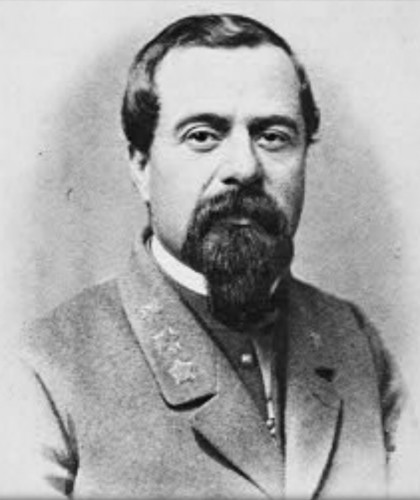
After the War, he was a successful lawyer and businessman in Vicksburg, Mississippi, and was president of the Mississippi Valley and Ship Island Railroad. In 1885, he was appointed registrar of the United States Land Office in Aberdeen, South Dakota, and then moved to San Francisco where he established a business in 1890. According to Jack D. Welsh, M.D., in Medical Histories of Confederate Generals (1994), Harris was an invalid for several years before his death. He died in Malvern, England, while on a business trip. Section 185, lot 21229.
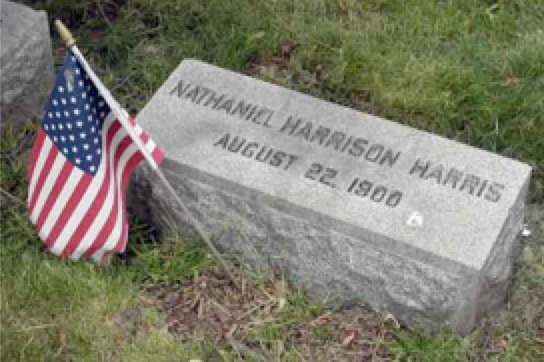
HARRISON, CHARLES L. (1841-1894). Private, 48th New York Infantry, Company K. Born in New York State, Harrison enlisted at Brooklyn as a private on March 21, 1862, and mustered into the 48th New York the next day. As per his obituary in the Brooklyn Daily Eagle, Harrison was instrumental in designing a theater for the entertainment of troops and officers when his regiment was stationed at Hilton Head, South Carolina. He offered his skills as an architect, raised money from his brigade to meet expenses, and painted sets and helped with the décor. His father, a professor in New York City, sent costumes. Harrison participated in the performances along with others in his regiment, some of whom played female roles. On June 1, 1864, he was wounded in action at the Battle of Cold Harbor, Virginia, and was discharged on November 10, 1864. His obituary states that he was present at the capture of Fort Pulaski, Georgia; the attack at Fort Wagner, South Carolina; the Florida Campaign, and the Battle of Drury’s Bluff, Virginia. During his service, he contracted rheumatism and malaria which troubled him throughout his life. In 1889, he applied for and was granted an invalid pension, certificate 546,961. A member of the Gouverneur K. Warren Post #286 of the G.A.R., his comrades paid tribute to him at his funeral. His last residence was 179 Madison Street in Brooklyn. His death was attributed to gout. Section 23, lot 8269, grave 6.
HARRISON, JAMES HENRY (1839-1879). Corporal, 132nd New York Infantry, Company F. A New York City native, he was a butcher by trade. After enlisting as a private at Brooklyn on August 28, 1862, he mustered into Company F of the 132nd New York on October 4. As per his muster roll, he was 5′ 7½” tall with hazel eyes, auburn hair and a dark complexion. He was stationed with his unit in New Berne, North Carolina, from 1862 to 1865, was promoted to corporal of his company at some point, and was discharged from service on June 29, 1865, at Salisbury, North Carolina. According to a descendant, he was wounded slightly at a skirmish on the outskirts of New Berne in October of 1864, but that injury is not noted in his soldier history. Harrison’s muster roll reports that he was assigned to the commissary department for some time during his service. His last address was 197 Third Avenue in Manhattan. In 1890, his wife applied for and received a widow’s pension, certificate 318,589. Section A, lot 8100, grave 88.
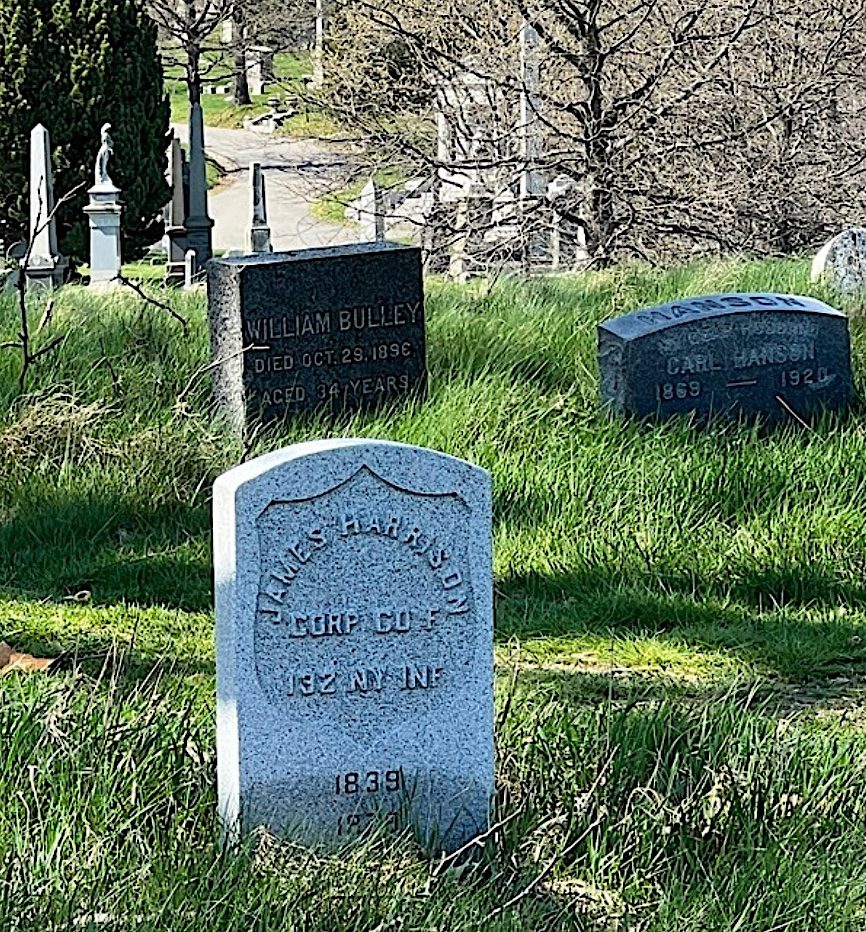
HARRISON, ROBERT (1828-1879). Private, 70th New York Infantry, Company B. Born in Ireland, Harrison enlisted as a private at New York City on May 6, 1861. On June 20, he mustered into the 70th New York and was discharged for disability on February 6, 1863, at Convalescent Camp in Alexandria, Virginia. Although he applied for an invalid pension on March 18, 1863, application 14,083, there is no evidence that it was certified. His last residence was 124 East 65th Street, Manhattan. Section 83, lot 1997.
HART, CHARLES (1824-1914). Private, 96th New York Infantry. Originally from London, England, although his muster roll incorrectly lists Canada as his birthplace, Hart immigrated to Brooklyn in 1845. During the Civil War, he enlisted and mustered into the 96th New York on August 15, 1864. According to his muster roll, he was a boatman by trade who was 5′ 7¾” tall with blue eyes, brown hair and a florid complexion. Listed as a substitute, he was not assigned to a company. Further details about his service are not known.
As per his obituary, Hart was a prominent lithographer who had an establishment at 36 Beaver Street in Manhattan for over fifty years, retiring at age 87. The obituary notes that he was the leading authority on lithographic work in the United States who was consulted by associates in his field whenever anything new or important was introduced in his trade. In addition, he was active in the Plymouth Church and an admirer of its famed spiritual leader, the Reverend Henry Ward Beecher (see). His widow testified that he owned no property but died an unnatural death, alleging that the Orange County Milk Company negligently caused his demise with its spoiled milk. His last residence was 444 6th Street in Brooklyn. Records indicate that his death was caused by senility. Section 81, lot 3915.
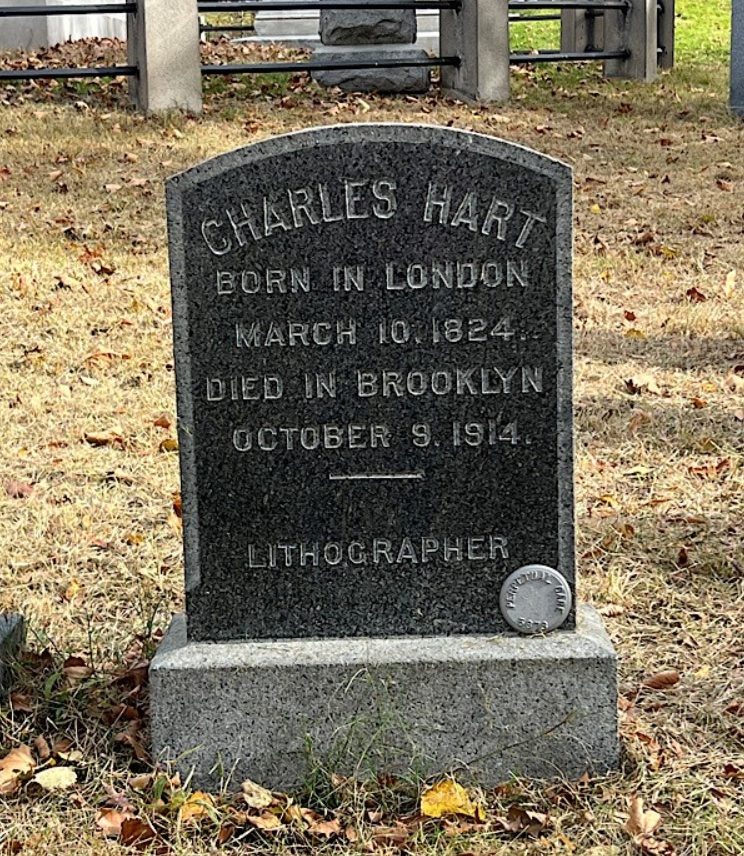
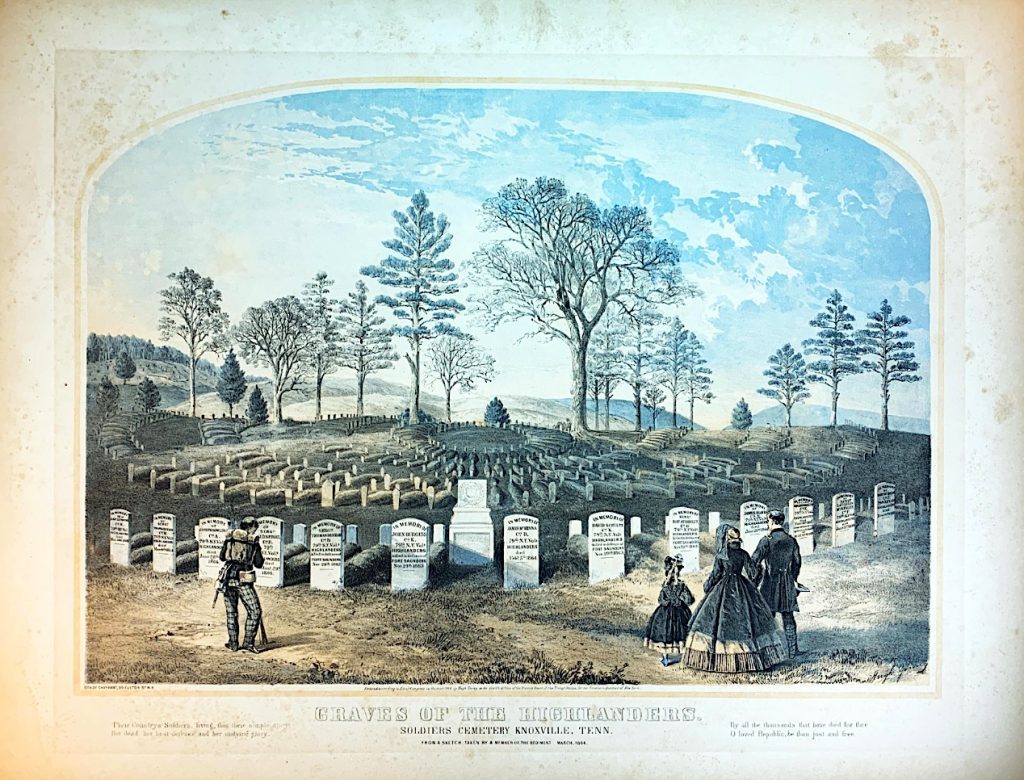
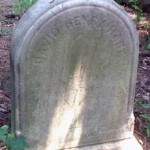
HART, DAVID H. (1836-1862). Sergeant, 59th New York Infantry, Company G. A native of New York and a resident of 184 Allen Street in Manhattan, he enlisted at New York City as a sergeant on May 1, 1862, and mustered into the 59th four days later. Hart was wounded at Antietam, Maryland, on September 17, 1862, and succumbed to his wounds in a New York hospital on November 29 of that year. One of his obituaries reports that he died from a secondary hemorrhage related to the original gunshot wound. He was interred at Green-Wood on December 2, 1862. Section 171, lot 14889.
HART, GIFFORD R. (1835-1883). Private, 7th Regiment, New York State National Guard, Company F. Hart, who was born in New York State, enlisted as a private at New York City on May 25, 1862, mustered immediately into the 7th Regiment, and mustered out on September 5, 1862, at New York City. According to the 1887 New York City Directory and the 1880 census, he was employed as a lawyer. He last lived in New York City where his death was attributed to poisoning. A newspaper article about his death reports that domestic trouble was the likely cause of his suicide. Section 60, lot 2963.
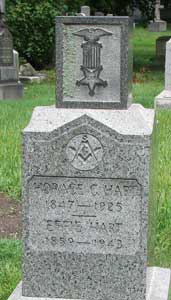
HART, HORACE (1847-1925). Corporal, 43rd New York Infantry, Companies G and C. After he enlisted at Camp Griffin, New York, as a private, on December 18, 1861, Hart, who claimed to be eighteen, immediately mustered into Company G of the 43rd New York. A clerk, he was 5′ 7″ tall with dark eyes, black hair and a light complexion. He was transferred intra-regimentally to Company C on July 7, 1862. At some point, he was taken prisoner of war and paroled at Annapolis, Maryland, in August 1863. Immediately after his discharge on December 24, 1863, he re-enlisted and returned to his regiment. At the Battle of Spotsylvania Court House, Virginia, on May 10, 1864, he was wounded in action and then wounded a second time on October 19, 1864, at the Battle of Cedar Creek, Virginia. On January 15, 1865, he was promoted to corporal and was reduced in rank to private on May 20, 1865, a month before he was discharged on June 27, 1865, at Washington, D.C.
In 1868, Hart’s application for an invalid pension was granted, certificate 188,400. A G.A.R. ribbon is on his burial site. The men of the 43rd felt close to their captain and, years later, when they visited the boulder where Gilfillan was propped against as he lay dying, the veterans placed shards of granite as a memorial to their fallen leader. Hart is buried near the grave of William Gilfillan (see), the captain of his company who was killed in action at the Battle of Gettysburg. It appears that Hart selected his grave site at Green-Wood so that he would be within sight of his captain. Hart’s last residence was 40 Tuxedo Avenue in Hawthorne, New Jersey. His wife, Effie Hart, applied for and received a widow’s pension in 1925, certificate 961,868. Section 162, lot 14378.
HART, JAMES (1828-1899). Private, 5th New York Infantry, Company G. Born in Staten Island and a resident of the Clinton neighborhood there, Hart was 5′ 7½” with brown eyes and hair and was a mason by trade. He enlisted as a private at New York City on April 25, 1861. After he was wounded in the right arm at Gaines’ Mill, Virginia, on June 27, 1862, he was discharged for disability due to paralysis of the hand and arm on October 1, 1862, at McKim’s Mansion Hospital in Baltimore, Maryland. (His muster roll incorrectly states that he deserted in October 1862.) On October 9, 1862, he applied for and received an invalid pension, certificate 13,332. After his death from pneumonia, his wife received a widow’s pension, certificate 478,583. Section 204, lot 30102.
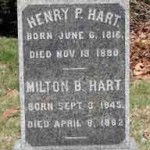
HART, MILTON B.(or D.) (1845-1882). Musician, 76th New York Infantry, Companies F and G; private, 93rd New York Infantry, Company E. Hart, a native of DeRuyter, New York, enlisted as a private on October 4, 1861, at New Woodstock, New York, and mustered into the 93rd New York ten days later. He transferred into Company F of the 76th New York as a musician on January 15, 1862. His muster roll indicates that he was on detached service at Camp Tyler, Baltimore, Maryland, from August through October 1863. On July 1, 1864, he transferred intra-regimentally to Company G where he served until he mustered out on October 20, 1864. His last address was 49 Wyckoff Street, Brooklyn. An article in the Brooklyn Daily Union Argus in 1882 reported that the Surrogate Court determined that a letter of administration was granted for his estate. Mary Hart, his widow, swore in an affidavit that he died without a will and had a personal estate valued at $2,600. In 1920, his wife was awarded a widow’s pension under certificate 904,168. Section 192, lot 23684.
HART, ROBERT McDERMOTT (or McDERMUT) (1840-1864). Colonel and lieutenant colonel by brevet; major, 159th New York Infantry, Company F; private, 12th Regiment, New York State Militia, Company A; 7th Regiment, New York State National Guard, Company C. A New Yorker by birth and a resident of 217 State Street in Brooklyn, he lived in Europe for four years before he enlisted at New York City as a private on May 25, 1862, having had previous service with the 12th Regiment in 1861 (where he contracted typhoid fever). He mustered into the 7th Regiment on June 19, 1862, served in Baltimore, and mustered out with his company after three months on September 5 at New York City. He re-enlisted at Brooklyn as a captain the next day and was commissioned into the 159th New York on October 5. The 159th was engaged in the expedition to Louisiana and took part there in engagements at Port Hudson and the Red River. He was attached to the staff of General Grover as an ordnance officer in 1863-1864 and was promoted to major and transferred to the Field and Staff on July 4, 1864. He was killed in action by a gunshot wound on October 20, 1864.
A fellow soldier wrote of Hart, “…Believing him to be dead however, & finding the fire of the rebels too hot for them, they reluctantly laid him down, that they might make their own escape. He thus fell into the hands of the rebels, who after robbing him of watch, coat, boots, etc. left him alone in a house by the way side. Here about midnight of the same day his friends found him, but no human aid could now avail him, and early in the morning of the 20th October another noble soul went home to God.” A report in the 159th regimental history noted, “Major Hart, of our Regiment, on General Grover’s Staff, was wounded and taken by the Rebels. He was not attended to in time, and lost so much blood as to cause his death.” His valor was highlighted by Colonel David Shunk, 8th Indiana and commanding officer, in his field report written five days later. In describing his action to protect the flank, Shunk wrote,”…In consequence of the dense fog, which existed at the time, the enemy advanced on the battery and were in a short distance of it before we could distinguish whether they were friends or foes, the more so as we supposed them to be a portion of the Eighth Corps, and notwithstanding we had received a very heavy fire from that direction we did not reply to it until they charged directly on the battery. Five pieces were withdrawn successfully and while attempting to save the last one Major Hart (of General Grover’s staff)…was killed….” In all, the 159th that day lost 28 officers and 304 enlisted men killed or wounded and 42 prisoners captured. Shunk concluded, “…I cannot close this report without referring to the bravery of the lamented Major Robert McDermott Hart (of General Grover’s staff), who was killed while cheering on the men in their attempt to save the last gun of Battery D, First Rhode Island Artillery, in him we have lost a noble, brave, efficient officer…” Hart was brevetted to lieutenant colonel and colonel “for conspicuous gallantry at Cedar Creek, Virginia, where he was mortally wounded.” In 1894, his mother, Mary A. Hart, applied for a pension, application 113,681. Section 60, lot 529.
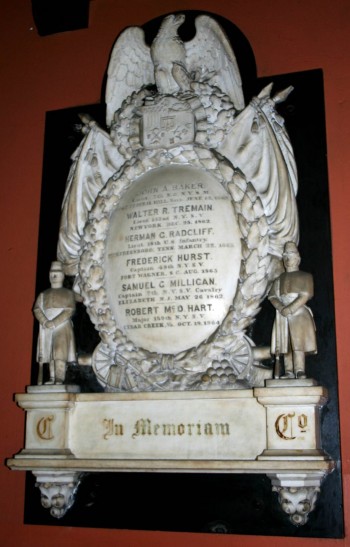
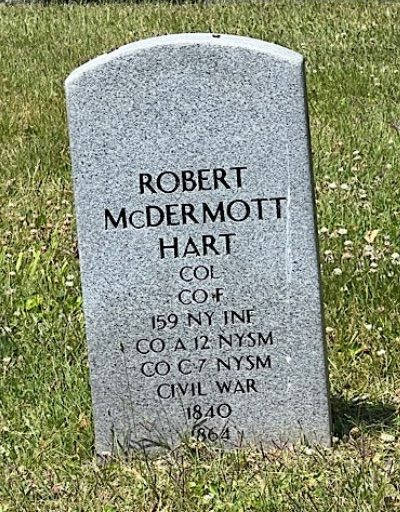
HARTER, FREDERICK A. (1834-1900). Private, 7th Regiment, New York State National Guard, Companies B and D. A native of New York State, Harter served with the 7th Regiment for its three month activation in 1862. His will, written in 1896, left his belongings to his wife, Isabella (who is interred with him), and his daughters, Isabella and Cornelia, who lived with him. As per his obituary, a funeral service was held at the Church of the Holy Trinity on Clinton and Montague Streets. His last residence was 143 Henry Street in Brooklyn. The cause of his death was typhoid fever. Section H, lot 17789.
HARTIG, ERNEST (ERNST) (1836-1876). Private, 6th Regiment, New York State Militia, Company B; 66th New York Infantry, Company K. Born in Germany, Hartig served with 6th New York State Militia before enlisting at New York City as a private on September 1, 1861, and mustering into the 66th New York on November 4. He was wounded on September 17, 1862, at Antietam, Maryland, and deserted on October 30, 1863. A locksmith by trade, Hartig last resided in Bay Ridge, Brooklyn.
Hartig’s death was caused by a self-inflicted pistol shot to the head. As per articles in the Brooklyn Daily Eagle, Rose Hartig testified at the coroner’s inquest about her husband’s death. She testified that Ernest Hartig had been intemperate in his habits and often talked about suicide. He offered to add a box of matches to their morning coffee so that the two of them could die together. She refused the offer and after breakfast, he went to the outhouse at which time she heard a gunshot without realizing what had happened. Mrs. Hartig discovered her husband’s body when she went to use the outhouse about a half hour later. The article noted that he had taken out a life insurance policy with the Continental Insurance Company for $1,000 in 1868 and that the weapon was an Italian-made revolver. The jury determined his death a suicide. It was noted that Hartig, to his credit and unlike many other despondent persons, did not take the lives of other family members before he ended his own life. There was no family funeral. Lot 18513, grave 28.
HARTLEY, JAMES (1839-1881). Corporal, 4th New York Heavy Artillery, Company G. Born in England, Hartley enlisted as a private at New York City on August 5, 1862, and mustered into the 4th New York Heavy Artillery that day. He was promoted to corporal on August 31, 1864, wounded on April 8, 1865, and mustered out on June 6, 1865, at Washington, D.C. A drowning victim, his body was found at the foot of Manhattan’s 200th Street, floating in the North River. In 1890, his wife received a widow’s pension, certificate 323,565. Section B, lot 8575, grave 921.

HARTLEY, MARCELLUS (1827-1902). Arms merchant and manufacturer. Hartley was born in Manhattan. His father, Robert Milham Hartley, was a merchant who was active in public health reform and the New York temperance movement. As per his biography on findagrave, Marcellus attended the old 37th Street School where he was a classmate of New York City Mayor Edward Cooper. His first job, after spending three years as a clerk with his father, was with Frances Tomes & Sons, importers of guns. In 1854, he established the firm of Schuyler, Hartley & Graham, later known as Hartley & Graham upon Schuyler’s retirement in 1876. At the time of Hartley’s death, the firm was known as the M. Hartley Company.
During the Civil War, Hartley’s establishment became prominent for supplying the Union with arms. He was a specialist in guns and ammunition. Secretary of War Edwin M. Stanton appointed him chief European purchasing agent for the Union Army, with rank equivalent to brigadier general. Hartley went abroad in 1862 and secured more than 200,000 arms and other equipment during his nine-month trip. He was also tasked with preventing guns from falling into the hands of Confederate agents in Europe.
A merchant who was well-known as an authority on financial and business affairs, Hartley was also prominent in the Manhattan Railway Company. He was a director and vice-president of the Union Metallic Cartridge Company which manufactured the first metallic cartridges. He was a director and president of the Bridgeport Gun Implement Company and later reorganized and was president of the Remington Arms Company. In addition, he was a director of the Western National Bank District Telegraph Company, the American Ordnance Company, the Audit Company of New York, the Equitable Life Assurance Society, the Fifth Avenue Trust Company, the German-American Bank, the Lincoln National Bank, the Mercantile Trust Company and the Westinghouse Electric and Manufacturing Company. Hartley was a trustee of the American Deposit and Loan Company and the American Surety Company.
Among the community organizations to which Hartley belonged were the Union League Club, the Republican Club, the Essex County Country Club, the Lawyers’ Club, the American Fine Arts and New-England Societies, the Presbyterian Union, the Metropolitan Museum of Art and the American Museum of Natural History. He was a benefactor of the Hartley House on West 46th Street, a charitable institution named in honor of his father, which helped the impoverished.
Hartley died while at a board meeting of the executive committee of the American Surety Company. Although help was summoned after he keeled over at his seat, he could not be revived. His funeral was held at the Madison Square Presbyterian Church. He was survived by his widow, Frances née White, whom he married in 1855, and one daughter; three of their children predeceased him, one in infancy. In 1903, brief memoir of his life including excerpts from his Civil War correspondence, was privately printed (De Vinne Press). Section 140, lot 23389 (vault).
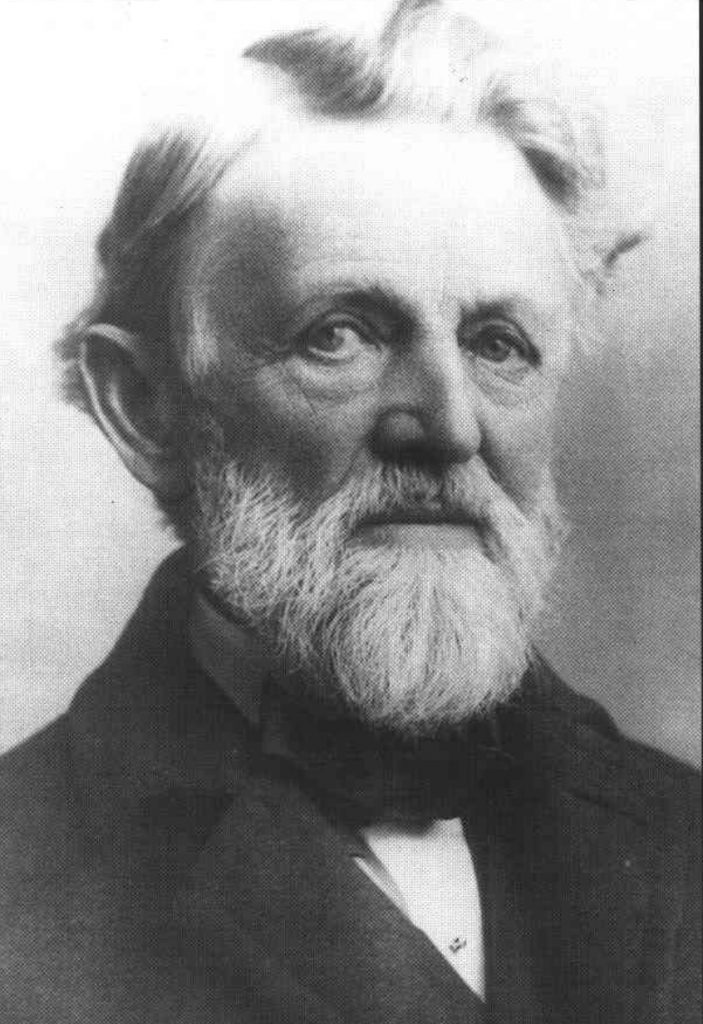

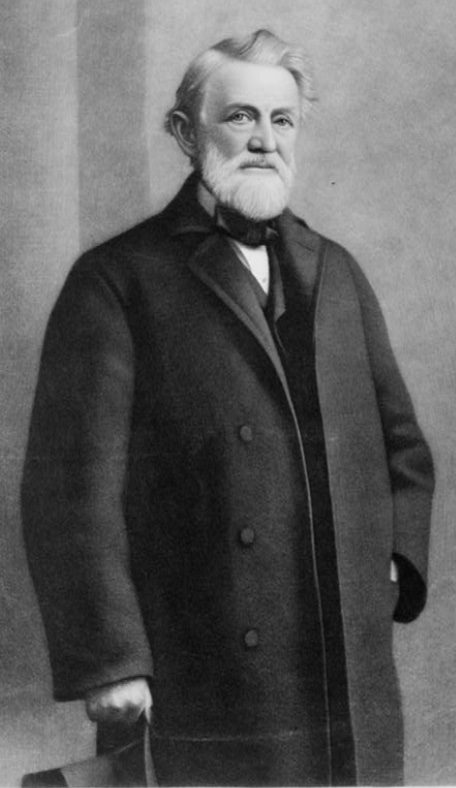
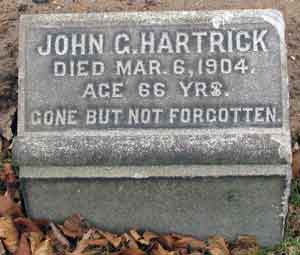
HARTRICK, JOHN G. (1838-1904). Private, 15th Pennsylvania Infantry, Company G. Of Canadian origin, Hartrick enlisted as a private on September 15, 1862, at Harrisburg, Pennsylvania, the same date that he mustered into the 15th Pennsylvania. He mustered out at Harrisburg on September 28, 1862. His last residence was 1751 Atlantic Avenue in Brooklyn. His surviving son stated in court papers that his father died of cancer without a will, had no other surviving heirs, and left possessions totaling less than $50. Section 13, lot 19694, grave 351.
HARTSHORNE, LAWRENCE PENNINGTON (1835-1869). First lieutenant, 71st Regiment, New York State National Guard, Company H. After he enlisted as a first lieutenant on May 28, 1862, at New York City, he was commissioned into the 71st New York State National Guard the same day, and mustered out after three months on September 2. He last lived on Quincy Street in Brooklyn where he died of consumption. In 1891, his wife applied for and received a widow’s pension under certificate 438,901. Section 53, lot 5581.
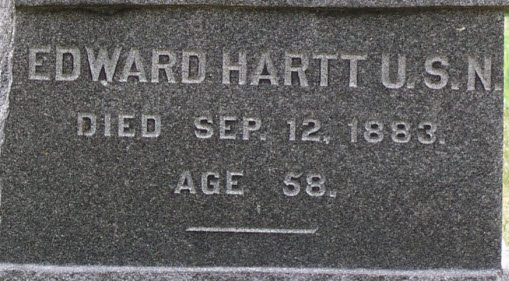
HARTT (or HART), EDWARD (1825-1883). Naval constructor, United States Navy. A New Hampshire native, Hartt enlisted as a Naval constructor on November 27, 1861, was commissioned in on that date and sent to New York. On May 19, 1862, he was ordered to St. Louis, Missouri, and later served at Philadelphia, Pennsylvania, as of December 5, 1864. At the time of his enlistment, he was paid $2,200 per annum, and he remained at that salary through 1864. (His salary rose to $3,400 in 1870.)
After the Civil War, Hartt was detached to the Navy Yard at Boston, Massachusetts, and commissioned as a naval constructor on July 25, 1865. After being detached in 1869, he returned to the Navy Yard at Pensacola, Florida, in 1871. He was promoted to commander as of March 3, 1871 (as per an act of Congress to date from his enlistment in 1861), and detached to the Navy Yard at Philadelphia as of June 20, 1873. On August 4, 1874, he rose to the rank of captain. On January 4, 1876, he was detached and assigned to special duty with the Centennial Exposition, then on December 15 of that year, detached to the Bureau of Construction and Repairs. On May 31, 1879, he was assigned to the Navy Yard at New London, Connecticut, until placed on orders on September 25, 1882, to serve as a member of the Board of Inspection and Survey. In 1883, his salary was $4,200. Active in the Democratic Party, he also enjoyed yachting in his spare time. He last resided on Dodd Street in East Orange, New Jersey. His widow applied for a pension after his death and submitted a document from Captain Richard Meade stating that Hartt suffered from a bad cold the last ten days of his life and was entitled to benefits related to death in the line of duty from exposure. Dr. Albert Gihon of the Navy concurred, reporting that Hartt suffered a congestive chill during his inspection of the USS Galena. Her widow’s pension commenced in 1883, certificate 3,107, at $30 per month. Section 107, lot 455.
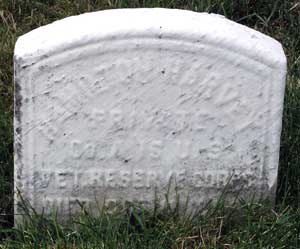
HARVEY, HAMILTON (1826-1896). Private, 57th New York Infantry, Company E; 16th Veteran Reserve Corps, Company A. Born in Ireland, Harvey enlisted on September 19, 1861, at New York City, and mustered into the 57th on October 16. He was wounded by a shell at Fredericksburg, Virginia, in May of 1863 and subsequently transferred into the Veteran Reserve Corps on July 1, 1863. He mustered out on November 24, 1865, at Harrisburg, Pennsylvania. On January 23, 1866, his application for an invalid pension was approved under certificate 105,821.
Harvey was admitted to the Soldiers’ Home in Dayton, Ohio, in June 1878 and discharged on February 21, 1884. He applied for assistance from the New York Almshouse on July 7, 1884, at which time he stated that was a laborer. Harvey returned to the Soldiers’ Home from August 11, 1884, until his unconditional discharge on January 5, 1889. In the 1898 Brooklyn Directory, he was listed as living at 163 South 8th Street and working as a clerk. The cause of his death was cancer. He last lived at 388 17th Street in Brooklyn. His wife applied for and received a widow’s pension, certificate 468,925. Section A, lot 8998.
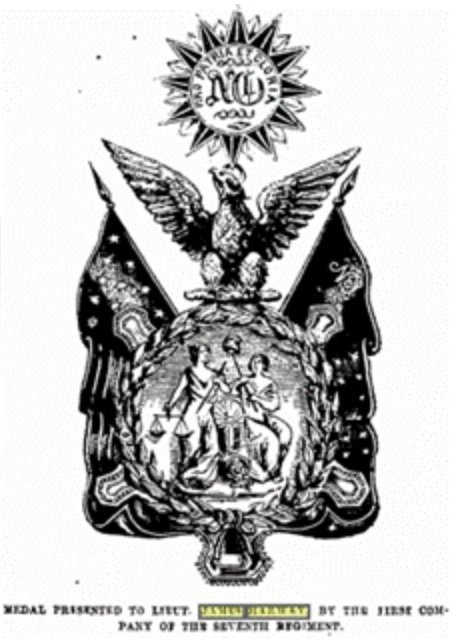
HARWAY, JAMES L. (1828-1901). Second lieutenant, 7th Regiment, New York State Militia, Company A. Harway, who was a lieutenant in the 1st Company of the National Guard, was presented with a solid gold pin by his comrades on December 30, 1859, at a testimonial honoring his social and military skills. The pin was hand-crafted and bore the National Guard motto, Pro Patria et Gloria. During the Civil War, he enlisted on April 17, 1861, at New York City, and was commissioned into the 7th Regiment nine days later. On June 3, 1861, he mustered out at New York City.
On April 18, 1874, Harway lost a lawsuit over a lease that he sold on the St. James Hotel on Broadway and 26th Street in New York City. Upon sale of the lease in June 1865 for $140,000, he was sued when the terms of the lease changed after one of the original purchasers died and left an infant as the heir. The Court ruled that Harway had to return $5,000 that he had collected from the plaintiff. Harway died of heart disease at home in Wallington, New Jersey. Section K, lot 16630.
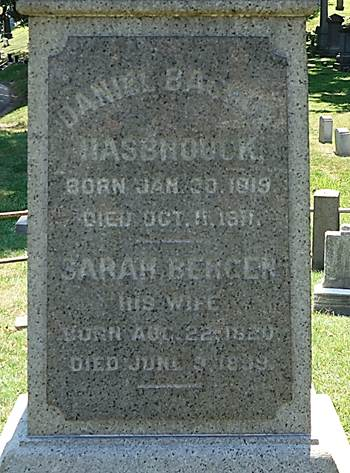
HASBROUCK, DANIEL BACKUS (1819-1911). First Deputy Clerk, Police Headquarters, New York City Draft Riots. A native of Syracuse, New York, he came to New York City in 1832 where he was in the mercantile business. After engaging in commercial endeavors in Onondaga County from 1840 through 1850, he returned to New York City where he was a volunteer with the Old City Fire Department for seven years. Hasbrouck joined the Metropolitan Police Department as a clerk in 1857. As per his obituary, he was instrumental in the organization of six regiments of militia among the police force in 1862. In another biography, he was credited with recruiting many men who were brought through the courts and was instrumental in recruiting five companies of infantry and two of cavalry. Although contemptuously called by some a “black Republican” during the War, his work was later appreciated and that epithet became a title of honor. He was commended by David Barnes in The Metropolitan Police, Their Services During Riot Week, Their Honorable Record for his indefatigable service during the New York City Draft Riots in July 1863. Another article during the Civil War reports that Hasbrouck offered to collect letters and packages at his house that he would bring to members of Brooklyn regiments who were stationed in Washington, D.C. In addition, he prepared lists of the dead, wounded and missing from the 173rd New York who fought in the Red River Campaign.
The 1870 census states that Hasbrouck was a clerk of police whose real estate was valued at $25,000 and personal estate at $5,000. From 1870 through 1876, he was in charge of the Bureau of Election for which he was paid $5,000 a year. In 1878, he left the Metropolitan Police and took a position as secretary and treasurer of the Houston Street, West Street & Pavonia Ferry Railway remaining until 1893 when the company became part of the Metropolitan Railway Company and he became its vice-president. In 1903, he became president of the Metropolitan Street Railway in New York which was then leased to the Interurban Street Railway Company. Hasbrouck continued working every day at his office at 621 Broadway until the last months of his life. He held leadership positions on many of the street railways in the New York City area and its surroundings. He last lived at 418 Sackett Street in Brooklyn. His death was caused by arteriosclerosis. Section 61, lot 8979.
HASHAGEN (or HASHUGAN), FREDERICK (1840-1894). Private, 176th New York Infantry, Company B. Originally from Hanover, Germany, he was drafted as a private at New York City on October 28, 1863, and mustered that day into Company B of the 176th New York. On July 8, 1864, he was at Barrack’s Hospital in New Orleans, Louisiana, and was listed as absent on the muster roll on October 1864. On May 31, 1865, he became a naturalized United States citizen. At that time, he was 5′ 7½” tall with a high forehead, full and oval face, blue eyes, brown hair, ordinary nose and a florid complexion. He was discharged with his company on April 27, 1866, at Savannah, Georgia. The Veterans Census of 1890 confirms his service. His last residence was 205 Columbia Street in Brooklyn. Hashagen died from nephritis. Section 163, lot 14877, grave 2.
HASHAGEN, HENRY J. (1844-1882). Private, 45th New York Infantry, Company D. A native New Yorker, he enlisted as a private at New York City on September 25, 1861, the same date that he mustered into the 45th New York. Wounded in action at Second Bull Run, Virginia, on August 29, 1862, he was sent to a hospital in Washington, D.C., from which he deserted on January 18, 1863. He last lived at 64 Jane Street in Albany, New York, where his death was attributed to an overdose of morphine. Section 59, lot 1400.
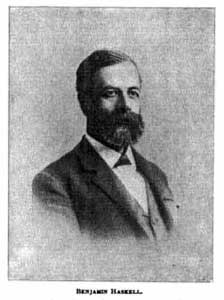
HASKELL, BENJAMIN (1835-1926). Major and assistant adjutant general, United States Volunteers Adjutant General’s Department; sergeant, 13th Regiment, New York State Militia, Company G. A New York City native, he was educated at the Davenport Academy in Brooklyn. Haskell joined the Brooklyn City Guard in 1855 and held the rank of corporal and then sergeant. During the Civil War, when the City Guard became Company G of the 13th New York State Militia, he served as sergeant for three months in 1861. He then re-enlisted as a major on June 18, 1863, and was commissioned as a major and assistant adjutant general in the United States Volunteers Adjutant General’s Department. Haskell fought at Gettysburg, Pennsylvania, and mustered out on July 24 of that year. On December 17, 1866, he was praised for his regiment’s skill in the execution of formations, marching, and dress parade.
In civilian life, Haskell was treasurer of the American Wood Decorating Company of New York, an establishment which produced machines for embossing or ornamenting wood in the home. Remaining interested in military affairs, he belonged to the Clarence D. McKenzie Post #399 of the G.A.R. Active in many civic organizations in New Jersey, he was a member of the Bloomfield Board of Education, the Board of Censors and the Essex Board of Trade. In 1906, he applied for and received a pension, certificate 1,142,741. He last resided at 24 Morris Place in Bloomfield, New Jersey, where he died of a cerebral hemorrhage at the age of 90. His engraved Smith & Wesson revolver in a custom leather flap auction sold at auction for $1,989. Section 183, lot 22520.
HASKELL (or HASKILL), CHARLES (1842-1901). Private, 93rd New York Infantry, Company D. Born in Peru, Massachusetts, Haskell enlisted in the 93rd New York in 1864 for a period of 100 days and mustered into Company D as a private. In 1891, his application for an invalid pension was granted, certificate 780,326. As per his obituary in the Brooklyn Daily Eagle, he died of a stroke at his desk at the United States Customs House in Manhattan. The obituary confirmed his Civil War service and noted that he worked for the New York City Department of Water Supply before taking his position at Customs in 1899. He lived in Brooklyn, last residing at 113 Columbia Heights. In 1923, his widow was granted a pension, certificate 949,883. Section 193, lot 31274.
HASLAM (or HASLOM), CHARLES (1845-1867). Private, 12th Regiment, New York State National Guard, Company E. Originally from Ireland, Haslam served with the 12th Regiment in 1863 when it was activated for 30 days. His last residence was 334 Eighth Avenue in Manhattan. His death was attributed to phthisis. Section 116, lot 10975, grave 1040.
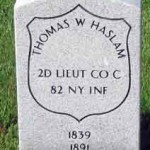
HASLAM, THOMAS WILLIAM (1839-1891). Second lieutenant, 82nd New York Infantry, Company C. A native of Ireland, he enlisted as a private and mustered into the 82nd New York on May 21, 1861. During his service, he was promoted to corporal and sergeant on unspecified dates, to first sergeant on November 20, 1862, and to second lieutenant on December 27. He was cashiered out, or dismissed from service for breach of discipline, on May 25, 1863. He last lived in Manhattan on West 42nd Street. His death was caused by a brain tumor. Although his widow, Margaret Haslam, applied for a pension in 1894, application 592,037, she apparently did not receive one. Section 206, lot 27211, grave 180.
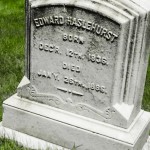
HASLEHURST, EDWARD (1836-1886). First lieutenant, 23rd Regiment, New York State National Guard, Company G. He enlisted as a first lieutenant at Brooklyn on June 18, 1863, was commissioned the same day, and mustered out after 30 days on July 22 at Brooklyn. He also served in the 13th New York Infantry, Company G, but the details are unknown. In 1865, he was promoted to captain of the 23rd National Guard. Most likely, he was related to Theodore Haslehurst (see). He last resided at 128 Lefferts Place in Brooklyn. Apoplexy was the cause of his death. Elizabeth W. Haslehurst, who is interred with him, applied for and was granted a widow’s pension in 1886, certificate 652,762. Section 123, lot 15260.
HASLEHURST (or HAZLEHURST), THEODORE (1843-1862). Private, 6th New York Infantry, Company F. Haslehurst is not buried at Green-Wood; a cenotaph citing his death on the battlefield is on his family’s monument at Green-Wood. Haslehurst enlisted as a private at Utica, New York, on February 9, 1862, and mustered into the 26th New York on March 27. He was killed in battle at Groveton, Virginia, on August 30, 1862. He was likely related to Edward Haslehurst (see). Fanny Haslehurst, his mother, who was a widow, applied for and received a pension in 1863, certificate 8,639. In her pension application to Oneida County, New York, on January 6, 1863, she swore that she had been dependent upon her son for support and that he left no widow or child in need of support. She also declared that she “has not in any way been engaged in or aided and abetted the rebellion in the United States.” In support of her claim, soldiers from his company submitted affidavits that they had shared his tent right before the battle and that Haslehurst was instantly killed by a gunshot wound to the left side, near his heart. Section 123, lot 15260.

HASSALL (or HASSELL), JOHN (1840-1922). Private, 9th New York Infantry, Company C. Originally from Birmingham, England, he immigrated to the United States in 1850, at which time his father established a wire nail factory in Brooklyn. Educated in New York City, Hassall first apprenticed as a book-binder. During the Civil War, he enlisted as a private on April 23, 1861, and mustered into the 9th New York, also known as the Hawkins Zouaves, on May 4. He saw action at the Battles of Newport News and Big Bethel in Virginia, and at Forts Hatteras and Clark in North Carolina. He had possession of a small presentation flag which his comrade obtained in battle at Roanoke Island and later willed to Hassall. In addition, he fought at the Battle of Camden (South Mills), North Carolina, and the Battle of Fredericksburg, Virginia. His regiment lost 63% of its men at the Battle of Antietam, Maryland. Hassall was discharged for disability on September 15, 1862, although one biography states that he mustered out in 1863, at the expiration of his term.
After returning home, Hassall was associated with a hardware store in Pittsburgh, Pennsylvania, for five years, but returned to New York after he was accidently shot in the right arm. He then worked for his father and upon his father’s death in 1888, became head of the business. A new three-story factory was built on Oakland Street in 1889, and, in addition to nails, the company manufactured among other things, tiny pins and rivets for spectacles, jewelry boxes and display cases, and gold pins that were special ordered by Tiffany & Company. As per his obituary, which confirms his Civil War service, he invented many devices that improved the machinery for nail-making. According to a descendant, Hassall was the treasurer of his regiment’s veterans association for 35 years or more. In addition, he was a past commander and chaplain of the Edgar A. Kimball Post #100 of the G.A.R., which he joined in 1873. A Republican in politics, he was also a member of two fraternal organizations, the Order of United Friends and the Stars and Stripes. He last lived at 671 Crescent Street in Astoria, New York, and had a summer home in Spring Fields, New York. Section 148, lot 21116, grave 6.
HASTINGS, EASTBURN O. (1833-1884). Private, 7th Regiment, New York State Militia, Company H. Born in New York, he was a brother of George Cranbury Hastings (see). As per his passport application at age 21, he was 5′ 8″ tall with blue eyes, brown hair, light complexion, aquiline nose, high forehead, sharp chin and oval face. In 1858, he purchased eight lots on 108th Street in Manhattan from his future father-in-law for almost $26,000. He owned thirty-one other lots in that area. (He married Adelaide Curtis on September 10, 1861.) During the Civil War, he served as a private for thirty days with the 7th Regiment when it was activated in 1861.
In 1864, IRS records note that Hastings was living in Sing Sing (now Ossining) in Westchester, New York, where his income of $500 was taxed at 3% for a total tax due of $15. As per IRS records of 1865, his income was $241, his three carriages were valued at $100, $200, $150, and his watch at $100. According to 1866 IRS records, he lived in a brick house in Croton that had a value of $1869 and tax due of $67.28. An architect, he was a member of the American Institute of Architects from 1870 until his death; Curtin’s Westchester Directory for 1871-1872 lists him as an architect. Hastings was also an art collector specializing in Oriental art. In 1878, he lent several items-vases, bowls, dishes and cups-to a loan exhibition at the National Academy of Design to benefit the Society of Decorative Art “Consisting of Gems of the Modern, Foreign and American Schools of Painting and Rare Examples of Various Art Industries.” At the time of the 1880 census, he was living in Sing Sing, New York, and was employed as an architect. The editors of the American Architect were notified of Hastings’s death with a tribute from the American Institute of Architects expressing condolences to his family and expressing their sense of loss on the demise of a long-time associate. Section 43, lot 1025.
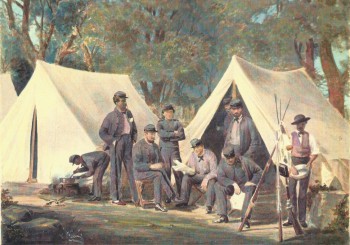
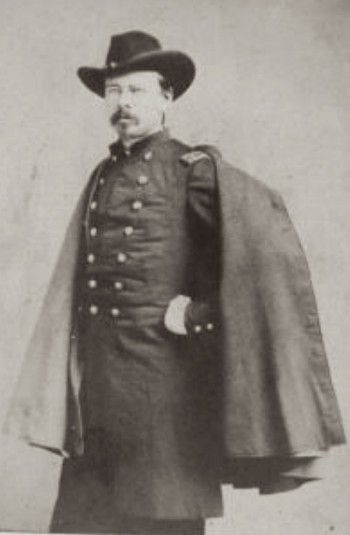
HASTINGS, GEORGE CRANBURY (1830-1873). Colonel and lieutenant by brevet; major, 1st United States Sharpshooters. A New York City native, his father was a wealthy merchant. Hastings entered Yale as a sophomore, studied for two years, and was granted a degree in 1854. He began studying law in New York City, then studied at Harvard Law School for one year from September 1853-1854. The 1860 census notes that he was living in Orange, New Jersey, and working as a lawyer. In the fall of 1861, Hastings raised a company of the 1st United States Sharpshooters, also known as Berdan’s Sharpshooters. He enlisted as a captain at New York City on August 15, 1861, and was commissioned into Company H of the 1st U.S. Sharpshooters on October 4. The regiment was part of the Army of the Potomac. The Regiment moved from Fort Monroe, Virginia, in March 1862 to Yorktown and then toward Hanover Court House in May 1862 where they used advanced tactics to find an enemy sharpshooter. They rigged a dummy soldier up and moved the dummy around until they located smoke from the enemy’s rifle. The Company fought at Glendale, Virginia, on May 30, then marched overland into Maryland but did not fight at Antietam.
He was promoted to major on September 22, 1862, and simultaneously transferred into the Field and Staff. Hastings had high expectations for his men to ensure that their weapons were kept clean and in good working order. He issued the following order [original punctuation]: “Arms and Accoutrements must be inspected daily and immediately before parade by Co. officers and all cases when Arms or accoutrements are not in good order the delinquent Must be promptly punished and for habitually Neglecting his Arms Must be reported to regimental Head Quarters.” Also held in reserve during much of the Battle of Fredericksburg, the 1st Regiment eventually headed toward Chancellorsville. After Hastings recovered from wounds suffered at the Battle of Chancellorsville, Virginia, in early May 1863, he was appointed to the staff of General George Meade as judge advocate of the Army of the Potomac. The Sharpshooters were present at the Battle of Gettysburg, Pennsylvania. After Lieutenant Casper Trepp (see) was killed at Mine Run, Hastings assumed command of the regiment. According to the Final Report of the Battlefield of Gettysburg, “Maj. George Hastings, through by nature a martinet, and not always popular, forced us to respect him by his bravery and gallantry.” As per his soldier record, his promotion to lieutenant colonel on January 2, 1864, was revoked. The 1st Regiment also fought at the Battle of the Wilderness in May 1864, Cold Harbor, Harrison’s Creek and Deep Run (August 16-16, 1864). Hastings was discharged on October 31, 1864. Subsequently, he was brevetted lieutenant colonel and colonel for “gallantry in the field.”
As per his obituary, which confirms his Civil War service, he never recovered from his severe wartime injury incurred “while in the saddle.” After his service, Hastings returned to his law practice then joined the Civil Service as a customs appraiser in New York Harbor. The 1870 census notes that he was living in Sing Sing, New York, and was a brick maker. In 1871, he was stricken with the paralysis that ultimately claimed his life. He was a brother of Eastburn Hastings (see). He last lived in Sing Sing (now Ossining), New York. Section 43, lot 1025.
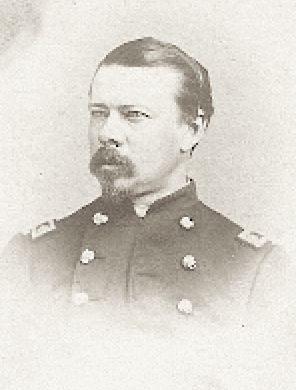
HATCH, JOSEPH H. (1844-1891). Musician, 162nd New York Infantry, Company G. After Hatch enlisted as a private on September 15, 1862, at New York City, he mustered into the 162nd New York and then was promoted to musician and served in the regiment’s band. After being reduced to the rank of private on February 17, 1864, he was promoted again to musician on February 28, 1865, before he mustered out on October 12, 1865, at Savannah, Georgia. He became a member of the G.A.R. as of March 31, 1868. As per his obituary, he was a member of the Mariner’s Council, the Veteran Zouave Association and the Sumner Post #24 of the G.A.R.; members of those organizations were invited to attend his funeral. His last address was 100 West 99th Street in Manhattan where his death was attributed to a skull fracture. Shortly after his death, his widow, Elizabeth Hatch, was granted a pension, certificate 336,532. Section 135, lot 27263, grave 1888.
HATFIELD, JESSE KIMBALL (1841-1893). Private, 6th New York Cavalry, Company A. As per his muster roll and online family tree, Hatfield was born in Geneva, New York; the 1880 census incorrectly reports that he was born in Brooklyn. During the Civil War, he enlisted and mustered into the 6th New York Cavalry at Brooklyn on September 18, 1862. As per his muster roll, he was a conductor who was 5′ 9″ tall with blue eyes, brown hair and a light complexion.
Hatfield wrote this letter to his mother about the Battle of Chancellorsville, and his experiences after he was taken as a prisoner. His original spelling and grammar are kept.
Battle of Chancellorsville
Anapolis Maryland May 18th 1863 My Dear Dear Mother I have not had an chance of writing to you since my last til now. I supose Dear Mother that you think that I am Ammung the things that wer But this will let you no that I am Ammung the things that is. My Dear Mother I have a good deal of news to let you now. I wrote to you in my last letter letting you that I thought that we were about to move Wel we did move. We left our camp on this 27th of April. We the 6th NY vol cav lead the advance. We advanced the 12th Army over Kellys Ford. We were not over the ford twenty minutes be fore we had a skirmish with the Rebs. We were fighting at day. We took a good manny Prisoners. We went on till we came to the Raperdam River. We went to Gimnanna Ford. We stood on a hill A body of infantry on the other side of the water. A voly into us killed one corporal and woundind one officer. We got of frome the top of the hill in the double quick slite out in A hollow. We then dismounted and crept up to the top of the hill and fired at the Rebs for over tow hours and they at us. We did not loose anny more men this time. We held them there tite out infantrycame up to our suport then the Rebs put up a white flagg they surrendered. We went on scurmishing al the way til we came to Chanclorville. There Hooker made his head quarters. The next day General Hooker told us to go three miles and feal of the enemy but not to engage them if he could help it. Our Cunall is acting Brigadeer General Our lieutenant Curnall was acting Curnall. We went 12 miles in the place of three. We went into the field and dismounted to rest. We had only sat down bi our horses When the Rebs fired into us from all sides. The Cornell gave the command Steady men Mount. We had a hard job to get into our saddles. The horses were so wild we thought that our owen men had fired into us in a mistake. We thought it was the 8thPA cav that fired. Our captain hallowed out Stop that fireing for God sake. You are fireing on your own men. We are the sixth NY. The Rebs yelled the louder and said that they was the third of VA. Our captain turned around to our Cornell and said Cornell they are the enemy. The Cornell told them that they would hear frome us soon the bugle sounded the charge. We charged at them. The Rebs broke and run in the woods. We charged on them four times and cut our way through and escaped. The Curnell was shot through the heart and fell dead with speakind a word. We lost fifty tow in killed and wounded and taken prisenors. Jacob Ward was taking prisenor. When we went back to camp ore to General Hookers Headquarter, Curnall Devin saw us. He took twelve men with him till he went to the Battle field. But he had hardly gone a half mile when he was fired at by a Rebble Picket. He turned around and came back. He demanded of General Hooker to give him the Command of his little Rigt. He creid like a little child. O take my men into such a place. He would never never have done it. He was like a wild man. We were only one hundred and eighty strong at the fight. The Rebs had a hole brigade with them. We were sent to guard Elysford to Campennys Camp A and B al fifty three men. We dismounted and went out scurmishing most al of the time on Sunday the third of may. We saw a large body of REbs on the other side of the ford. We sent a man up to General Hooker for reinforcement but the man did not come back. He was captured by the Rebs I think. Wel our captain saw that he was cut off frome his Rigt he made up his mind to try and cut through if he. So he said boysI am going to my Rigt will you go with me. We al said yes yes go Ahead. So we started up the street at full spead yelling as loud as we could to make the Rebs be leave that we was an large forse when we got in front of the Rebs. They fell back in to the woods and gave us an voley. They killed nobody. They shot my horse Billy Boy is no more. Ten of our horses fell in a heap. I got a slight scratch on my head and slightly brused. Owen Murphy is cut and brused very bad. I dont think that he will live. We were taken prisenors tenn of us. We had an hard time of it. We had only four crackers in eight days. The Rebble Soldiers used us very good but the oficers used us very bad. I was quite sick. We went to Bell Island. My Dear Mother I would write you a book full of news. We walked one hundred and tenn miles to city piont where we were paroled. I pased the the Rip Raps and hanton Roads saw the cumberland and the Congress. These ships were sunk by the Merymack. Show this letter to the Dr Doctor Skerritt. Give him my love and tell him I will write to him very soon. Adress all letters to me Camp Parole Anapolis Maryland Comp A 6th NY vol Cav. your sonJesse K Hatfield write soon Dear Kind Mother I sent you thirty dollars and Amanda tenn Dollars in all fourty Dollars the day I started I did not pay the expenses. My Dear Sweet mother I tore up your likeness So no Reb should have it. But Dear Mother you layed over my heart in the bible protecting me in all of the fight. The Rebs took the bible. I hope it will do them good Dearist Mother I have not told you one half ore one third of the news. We saved General Hooker frome beingtaking Prisoner. Yours ever Jesse K Hatfield NB Please send me some postage stamps and envelopes directed. I lost everything. Yours Jesse K Hatfield
The following letters, which were copied by a descendant, retain their original spelling and grammar. Hatfield wrote this first letter to his brother describing the rough times his regiment had at the Battle of Brandy Station, Virginia, in which his captain was taken prisoner. He also describes the march through a wealthy rebel town during which his regiment helped themselves to the fine provisions in the homes—preserves, pickled oysters, butter and bread; he had noted earlier in the letter how the rebels stripped the clothing off the dead and wounded Union troops.
Warenton Virginia Oct 22th 1863Mr. Wm A HatfieldMy dear Brother I receaved your last letter. Was very glad to no that you and al of the folks at home ar al wel. I have had no time to write before to you. I am wel and hapy at preasant. I with the rigt have bin on the march for the last twelve days. Skirmishing and fighting with the Johny Rebs evry day boath on foot and mounted. We have had a prety rough times of it. Our Captain has bin taken prisenor. If we had at Brandy Station bin five minutes later we would have bin cut of and al of us have bin captured. We got there just in time. We charged on the Rebble Cavalry five times there and drove them evry time and captured quite a number of them in evry charge. the third charge was the hardest. in that charge our captain was taken, his horse got shot and the Rebs got him. He fought them like a man. He is an soldier, evry inch of him. I do not know how we al escaped. The shot and the shell came in Amung us like hale But I think that God was with us and He made them harmless. We lost only to men in Our company. One killed and one wounded. Company B lost thier Captain and eight men kiled and a number of wounded Company C had to men nocked to peaces bi a shell and lost prety heavy. I think that twenty five or thirty is al our Rigt has lost. We have bin very lucky. My dear Brother, Chancelor Ville Was nothing to these last twelve days of fighting. WE had no big Battle like the Chancelor Ville but we had more fighting to do than we had there. We dismounted and fought their Infantry. We only had our carabines and they had their long ranged Rifles But we held the Rebs and saved the Wageon train. We layed down flat on the ground and when a Johny Reb would show him Selve we would fire at him. one day we fired seventy rounds of carbine cartrages so you no that we had some hot work. We fel back very sloly one day and the next day we went to work and drove the Johnys Back on the double quick Al of the dead that fel in to their hand, they striped of their clothes and in some cases the wounded and left them laying there. We covered the retreat of Gen Mead. We are in Bufords division, Sekond division and first brigade. When you see in the papers any thing A bout Bufords division you wil no that its us. They do not mention the Rigts but seldom but Divisions. Kilpatricks Division lost very heavy. He is on ?. He only wants to get his owen name up and does not care for his men. We saved him When he got into A tight spot to or three times. Buford likes his men and looks before he leaps. when he under takes to A thing, he does it. He says that He is proud of his men, That they fought so stubborn against such great odds and disadvantages and trying times. We being up night and day, our horses gave ot. We got new ones and some of them gave out to and men has gone after more. Its very hard on horses. Buford Says that He wil do evry thing in his power to get his men A fifteen days furlough. He can do it and he wil do it. He can and wil. He wil let one Rigt go at A time. Yester day we went through Snakers Gapp and A nother Gapp. I for got the name of it. We stoped at a very Beautiful little vilage through the Gapp. Its name was White Plane. The houses was large and Splendid. The People Was mostly Wealthy But Bitter Rebs. They would not sel any thing to the nasty pest yanks. We were al quite wel satisfied with their turms, So when they told us they would not sel to us We went to work and helpted our selves. We to our surprise found A whole lot of ? goods in their houses such as cans of Pickled Oysters and Preserves and other things. We had an good time of it. We took a good stock A long with us. got as much buter as I could cary with me and warm cakes and bread. Got evry thing that we wanted in the eating line, captured to of Moysbies Gurillas in the town. It wis one of the Mosbies Headquarters. We have it rough and Hard with some good times now and then. I do not no how long we are going to stay in this place. I was here last here If you remember. My Dear Brother I must close this letter. Write Soone. By Bi Your Friend and loving Brother Jesse K Hatfield NB Give My love to Motherdear. Tel hur that I wil write to hur as soon as I get time. Give My love to Anna, Amanda, Brother Charlie and the Doctors Skerritt and Sebriton. I have just receaved the following dear dear letters by the male, Dear kind Mothers of the 23th of Sept, Sister Amandas Sept 29th, Charlie Oct 9th. A got the dollar in Sister Amandas letter and six stamps. Give love to al, Your loving Brother Jesse K HatfieldTo Mr Wm Hatfield
Hatfield wrote the following letter to his mother from the hospital. He worried that his mother was short of cash and that that he could not help her because he had not been paid for nearly six months. He vows that although he wants to go home, he has a duty to preserve the values of the flag. This letter retains his original spelling and grammar.
Calvary Corps Hospital, VA August 5th 1864
No blot on the banner of light. No slave in the land of the free. No wrong to be rampant. Where all should be right. No sin that shame XXXX to see. Calvary Corps Hospital, VA August 5th 1864 My dear beloved Mother. I received you dear kind loving letter of the 23rd 1864. Was very thankfull and happy to find you all well at home. I am at preasant well and contented. The wheather out here is very hot. I think before very long that we will move the Hospital. To day My Rigt embarked on transports I think for Penselvania or Maryland. I am very sorry that I could not go with them. I tried very hard to go But Dr. Mitchell would not let me go with them. I do not know how General Grant is making out at Petersburgh. I think that he will have to Retreat and Evacuate before long but even if he does do not feal discouraged for We will yet Whip the Rebs. The invasion in Maryland and Penselvania Will not Maltaryaly intifear with Grant before Petersburgh. My ever and always dear kind Mother I feal sorry that Brother Williams orderd off to Washington The Way things are at home. I think that you have to live very close. I wish We could get our pay that I might send you some money. The government owes me nearly six months pay. When I get payed I will send it home to you My dear Mother. But when it comes it will be good no doubt My ever dear Mother. Our rigt has lost A good many men in killed and wounded since I were last with them. Joseph Ward is well John Pickett is also well John Dooley is still sick in the Hospital but not doing seronsly sick. There is an average number of five deaths in this Hospital every day. There is no great news to write About just now. I hope that I can write some good news in our next letter My dear loving Mother. I received Sister Amandas letter with hur likeness. It is A good one and I had to give it a kiss. It looked so much like hur that it put me in mind of home and all of the ones that I love so dear. I farly jumped for joy when I received it But after all it Was no such thing as home. This fall My time expires and then Home I will go and see you all and then be real hapy But I cannot stay at home you no of corse if this rebellion is not put down. I went to the Wor to help save my Country and I will not give it up till the Rebles be come Loyal to our noble flagg. The stars must always shine bright. Dear Mother Give My love to sister Anna Amanda Wm and Charlie and dear good Grandmother Davison. I now must bid the good day. May God spare your dear X life land and you be hapy is the prayer of your loving son. Jesse K Hatfield
He was detailed to the Ambulance Corps at City Point, Virginia, in October 1864. On June 5, 1865, he mustered out at Cloud’s Mills, Virginia.
The 1870 census reports that he lived in Brooklyn with his mother and two brothers; he then worked as a clerk in an office. On August 28, 1877, he married Katie L. Schattenkircher in Brooklyn. According to the 1880 census, he lived at 124 23rd Street in Brooklyn, was married with one son and worked as a railroad conductor; that census reports that he was a Mason.
Hatfield was a ten year veteran of the mounted police force in Prospect Park, Brooklyn, who was well-known for his ability to bring back runaway horses. He was going home after ending his shift at work just before noon when he met his untimely death. While attempting to board a trolley car at Ninth Avenue and 9th Street, he fell off and was crushed by the wheels of the tram. The driver applied the brakes to shut off the power, but it was too late to avert the tragedy. (The driver was arresting pending the report from the coroner’s inquest.) Numerous local newspapers reported on the grim details of the accident, noting that nearly every bone in his body was broken and his body mangled. Survivors of the 6th New York Cavalry and members of the Ulysses S. Grant Post #327 of the G.A.R. were invited to attend his funeral. Hatfield left behind a wife and four children, the eldest was only ten. He last lived at 124½ 23rd Street in Brooklyn. Shortly after his death, Katie Hatfield, applied for and received a widow’s pension, certificate 404,120. Section 60, lot 184.

HATRY, JOSEPH AUGUSTUS (1829-1886). Captain, 159th New York Infantry, Company D; second lieutenant, 10th New York Cavalry, Company D. Originally from Alsace, France, Hatry enlisted as a second lieutenant at Elmira, New York, and mustered into Captain Emery Purdy’s Company of the 10th New York Calvary on December 23, 1861. He was discharged upon his resignation on July 30, 1862. His muster roll notes that he was also borne as Joseph A. Hattery. He re-enlisted as a captain at Brooklyn on September 2, 1862, was commissioned into the 159th New York on September 24, and was dismissed on November 16, 1863. The 1863 Draft Registration lists his occupation as druggist.
As per Hatry’s passport application of 1867, he was 5′ 8″ tall with a high forehead, hazel eyes, brown hair, sallow complexion, large nose, round chin and long face. According to the 1870 New York City Directory, he was a druggist at 97 William Street in Manhattan while living in Brooklyn at 66 Lafayette Avenue. At the time he became a naturalized citizen on June 21, 1871, he was employed as a jeweler. The 1877 New York City Directory indicates that he was a druggist at 6 Maiden Lane. He last lived in Roselle, New Jersey. Hatry died of pleuro pneumonia. In 1890, Lucy Hatry applied for a widow’s pension, application 488,785, but it was never certified. In 1892, an application for a minor’s pension, application 566,296, was filed, but it was not certified. Section 51, lot 7082.
HAWKINS (or HAWKING), CHARLES H. (1839-1864). First lieutenant, 4th New York Cavalry, Company C. Hawkins, a native of England, enlisted at Yonkers, New York, as a first sergeant on August 29, 1861, and mustered into the 4th New York Cavalry on that day. He was promoted to second lieutenant on January 1, 1862, and wounded near Strasburg, Virginia, on June 2, 1862. As per an article about his injury in The American Medical Times (1865), a conoidal ball from a Colt revolver entered his right thigh, fractured the femur, and lodged about five inches above his knee. After lying all night in the rain, he was brought to the regimental camp about 3:00 p.m. the next day, at which time the ball was removed by the regimental surgeon. Hawkins was then transferred by ambulance to the hospital in Strasburg where the wound was dressed in a straight splint with moderate extension and counter-extension applied. After ten days in the hospital, he was carried on a stretcher to a private house where he remained for seventeen days during which time two bone fragments were removed.
Hawkins then returned to a tent hospital in Middletown for nine days and then was transferred to Winchester where the splints were removed and the wound bandaged. On July 19, he was sent to Baltimore, Maryland, on a railroad car and was admitted to Camden Street Hospital the next day in “unpromising” condition with fever, a partial union of the fracture, and a much deformed limb that was three inches shorter than his good leg. It was determined that no apparatus be applied to the leg and that efforts were to be made to restore Hawkins to good health through a wholesome diet. On October 1, 1862, the entrance to the wound was enlarged, bone fragments were removed and deformed callus was chiseled, but, after some time, it was determined that the femur remained diseased. He was discharged for disability on February 3, 1863.
On February 10, 1863, he was promoted to first lieutenant with rank from October 11, 1862. Hawkins was transferred to the Ladies Home Hospital in New York City on April 5, 1863, and upon admission he was in much pain with greatly reduced strength and wounds that discharged profusely. Dr. Alexander B. Mott (see) amputated the leg at mid-thigh on April 29, but there was not much improvement despite daily cleanings with an iodine solution. Again, efforts were made to restore Hawkins’s health, even adding brandy to his diet. On January 6, 1864, he applied for and received an invalid pension, certificate 26,329. On April 4, 1864, he was transferred to St. Luke’s Hospital, a civilian facility. Again, much effort was expended to restore his anemic health. On September 21, 1864, one last effort to remove the diseased femur stump took place but the operation failed; ether had to be terminated and Hawkins was given brandy in its stead. He died the next day, enduring twenty-four hours of great suffering. According to cemetery records, he was a lieutenant who died at St. Luke’s Hospital in New York City from “decay of thigh bone.” Section 188, lot 15719.
HAWKINS, JOSEPH (1831-1871). Private, 84th New York (14th Brooklyn) Infantry, Company A. On April 9, 1861, Hawkins, who was originally from England, enlisted as a private at Brooklyn. He mustered into Company A of the 14th on May 23. On September 19, 1861, he was discharged for disability at Alexandria, Virginia. His last residence was at 2 Stewart Street, Brooklyn. Section 85, lot 5205.
HAWKINS, ROBERT F. (1829-1862). Private, 13th Regiment, New York State Militia, Company B. Of English birth, Hawkins served in the 13th New York State Militia for three months in 1861. He died from gangrene the next year in Georgetown, D.C. Section 114, lot 8999.
HAWKS (or HAWK, HAWKES), HENRY (1832-1878). Private, 31st New York Infantry, Company G. Hawks, a native of New York City, enlisted there as a private on May 13, 1861, and mustered into the 31st New York on May 27. The New York Herald reported that he was severely injured in the thigh near Fredericksburg, Virginia, on May 2, 3, or 4, 1863. He mustered out at New York City on June 4, 1863. In civilian life, he was listed as working in the tag business at 202 Broadway in Manhattan. His last address was 117 Pacific Street in Brooklyn. Mary Hawks, his widow, appeared before the Surrogate’s Court in Kings County after his death from convulsions and testified that Hawks left no will and that she and one adult daughter, Josephine Hawks, were the sole heirs to his estate valued at $1,500. Section 154, lot 32365.

HAWLEY, HARVEY (or HARRY) P. (1842-1862). Second lieutenant, 82nd New York Infantry, Company C. Hawley, a native New Yorker, enlisted there as a private on May 21, 1861, and mustered into the 82nd New York that same day. During his service, he rose through the ranks to first sergeant and then to second lieutenant on February 24, 1862. He died on June 2, 1862, succumbing to a gunshot wound he had sustained two days earlier at Fair Oaks, Virginia. As per a report on his death, he was “the first officer slain of that regiment whose glorious muster-rolls numbered nearly five thousand men.” Interment at Green-Wood took place on October 14, 1865. Section 78, lot 1999.
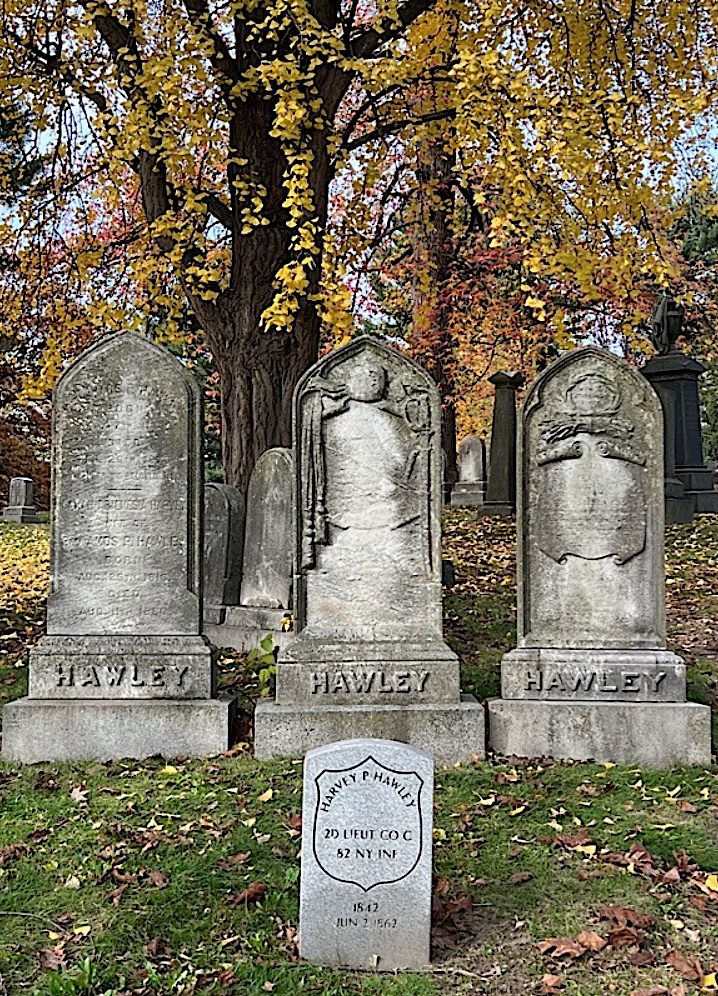
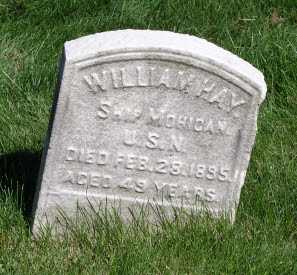
HAY, WILLIAM (1846-1895). Ordinary seaman, United States Navy. Originally from Scotland, Hay enlisted as a first class boy in the United States Navy on July 18, 1862. At that time, he was 5′ 5″ tall with hazel eyes, brown hair and a fair complexion. He first served on the USS North Carolina until July 28, 1862, at which time he was transferred to the USS Princeton until October 17, 1862. He then served on the USS Mohican (where he was treated for diarrhea), until April 28, 1864, when he returned to the North Carolina until June 6, 1864. His last vessel was the USS Manhattan, where he was captain of the forecastle. He was discharged July 28, 1865, with the rank of ordinary seaman, at New Orleans, Louisiana.
In 1894, Hay applied for a pension from the Navy citing that he suffered from chronic rheumatism, kidney trouble, piles and defective eyesight, traced to exposure aboard the Manhattan. At that time, he was 5’6½” tall and weighed 176 pounds. One record indicates that he had a greatly swollen left knee, “fatty heart,” and a weak and irregular heartbeat upon exertion. His personal physician testified that Hay was a moral man with good habits whose decline in strength and confinement to his house for one-third of the time in recent years was attributable to exposure. Hay’s pension application was approved under certificate 32,183. His pension papers also indicate that he was unable to support himself by manual labor. As per his death certificate, he worked as a clerk. His last residence was at 234 5th Avenue in Brooklyn. Eliza Hay applied for and received a widow’s pension from the Navy, certificate 10,704. His Naval service is inscribed on his government-issued gravestone, circa 1900. Section 135, lot 27263, grave 1045.
HAYDOCK, ISAAC (1836-1902). Landsman, United States Navy. Irish-born, Haydock enlisted as a landsman in the United States Navy on September 24, 1864, and served on the USS Vermont and USS Muscoota. He was 5′ 6½” tall with blue eyes, dark hair and a dark complexion. On September 7, 1865 and September 20, 1865, he was absent from duty suffering from intermittent fever. He last served on the USS Vandalia. He was discharged from the Navy on September 23, 1866. He is listed on the Brooklyn Veterans Census of 1890.
In 1898, he applied for and was awarded a pension for “inability to earn support,’ certificate 43,888. Haydock cited numerous ailments in his pension application including deafness in both ears, a double hernia, rheumatism, defective vision, lumbago, and catarrh. Haydock’s comrades testified that he was industrious and sober and remember that he suffered from fevers and had an injury while onboard the Muscoota. At his 1898 physical, he was 5’5½” tall and 150 pounds. The doctor’s report agreed that he did suffer from the ailments noted and was unable to hear ordinary conversation at six feet. His last residence was 362 Atlantic Avenue in Brooklyn. In 1902, Mary J. Haydock applied for and was granted a widow’s pension in 1902, application 21,521. Ms. Haydock asked for an increase in the $8 a month pension, citing that she supports herself by washing and was left no property, stocks, bonds, insurance, etc., but her application was denied because the said amount was set by law. Section 24, lot 5710, grave 2.
HAYES, JAMES (1847-1918). Seaman, United States Navy. Originally from Belfast, Ireland, Hayes enlisted in the United States Navy as a seaman and served during the Civil War. Details of his service are unknown. His obituary, which confirms his Civil War service, notes that he was a resident of the United States for 60 years. In civilian life, he worked as a stevedore foreman for thirty-four years and, at the time of his death, was a foreman in the Department of Highways. Hayes was a member of the Grand Army of the Republic, Navy Post #518. His last residence was 217 Pearl Street, Brooklyn. Section 129, lot 27373, grave 141.
HAYES, JOHN S. (1844-1866). Private, 21st New Jersey Infantry, Company D. After Hayes enlisted as a private on August 22, 1862, he mustered into the 21st New Jersey on September 15, and mustered out on June 19, 1865, at Trenton, New Jersey. On January 19, 1864, his application for an invalid pension was granted, certificate 29,580. As per his death certificate, he was single and worked as a mechanic. In 1868, Jane Hayes, his mother, applied for and received a pension for his service, certificate 129,798. Section B, lot 11005, grave 75.
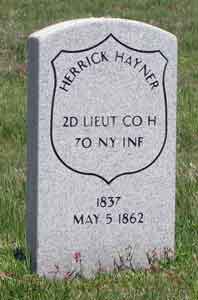
HAYNER, HERRICK (1837-1862). Second lieutenant, 70th New York Infantry, Company H. Born in Troy, New York, he was educated there and in Vermont before he entered Yale in 1854. Hayner was forced to leave in his second semester because of chronic catarrh (cough). When his health improved, he studied law as a clerk in New York City, was admitted to the Bar, and was a partner with his father until he left to fight for the Union. He told his father, “It should not be said he took no part in quelling so wicked a rebellion.”
Hayner enlisted as a second lieutenant at New York City on January 1, 1862, and was immediately commissioned into the 70th New York. As per a biographical sketch of his father, Yale class of 1826, Hayner was attached to the Army of the Potomac under General George B. McClellan. On May 5, 1862, at the Battle of Williamsburg, Virginia, he took command after his captain had fallen, waved his sword and ordered his men to charge the enemy. At that moment, he was killed instantly when his heart was pierced by a bullet. After his body was recovered, it was discovered that the bullet had lodged in his clothing and fell out when the body was disrobed for embalming. Hayner’s classmates, who knew him for only a short time, valued “his sterling qualities of heart and mind.” They said, “He engaged in the war with the utmost earnestness and the most unselfish devotion. That he would have achieved distinction as a soldier, had his life been spared, none who knew him can doubt; but his ambition was not for rank, but to contribute to the triumph of the national cause, and for that he willingly gave his life.” He was interred at Green-Wood on May 20 of that year. Section 122, lot 9895, grave 858.
HAYNES, FREDERICK R. (1843-1867). Private, 13th Regiment, New York State National Guard, Company B. Originally from Brooklyn, Haynes enlisted there on May 28, 1862, as a private. That same day, he mustered into Company B of the 13th Regiment and mustered out three months later on September 12 at Brooklyn. His last residence was 916 Myrtle Avenue in Brooklyn where he died from phthisis (tuberculosis). Although his father applied for a pension in 1890, application 468,846, there is no certificate number. Section 185, lot 18545.
HAYS, GEORGE W. (1833-1876). Private, 8th New York Heavy Artillery. Of Irish birth, Hays enlisted at Brooklyn as a private on February 23, 1864, and immediately mustered into the 8th New York Heavy Artillery but was not assigned to a company. He deserted at Fort Federal Hill in Baltimore, Maryland, less than a month later on March 16. His last residence was 300 West 51st Street in Manhattan. Section 179, lot 22347.
HAYWARD, HENRY (1845-1927). Unknown soldier history. According to his obituary in The New York Times, Hayward was a Civil War veteran. A hay and grain merchant in civilian life, he was active in many organizations including the Winchester Post #197 of the G.A.R., the Park Slope Masonic Club, the Brooklyn Masonic Veterans, and the Royal Arch Masons. As per his obituary in the Brooklyn Daily Eagle, he also belonged to the Society of Old Brooklynites. Members of all organizations to which he belonged were invited to attend his funeral. He last lived in Brooklyn at 244 11th Street. Section 206, lot 34271.